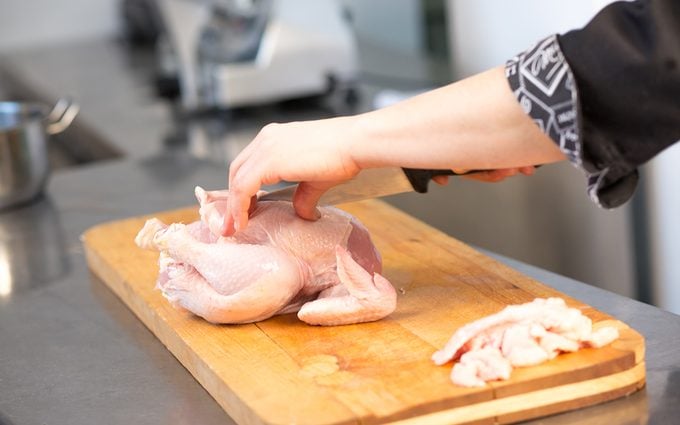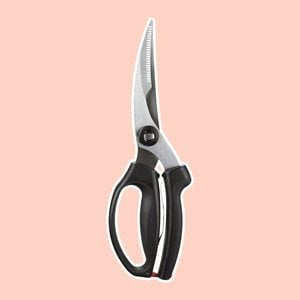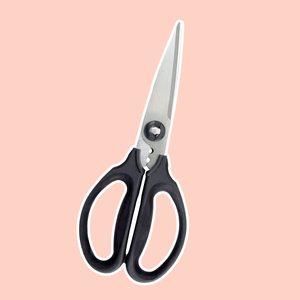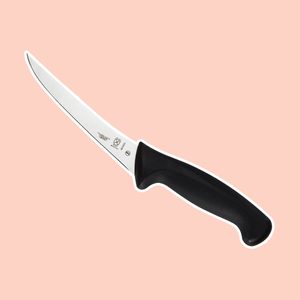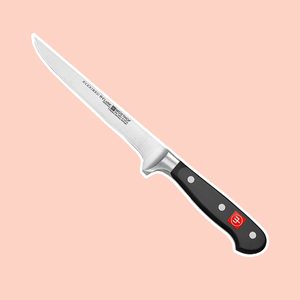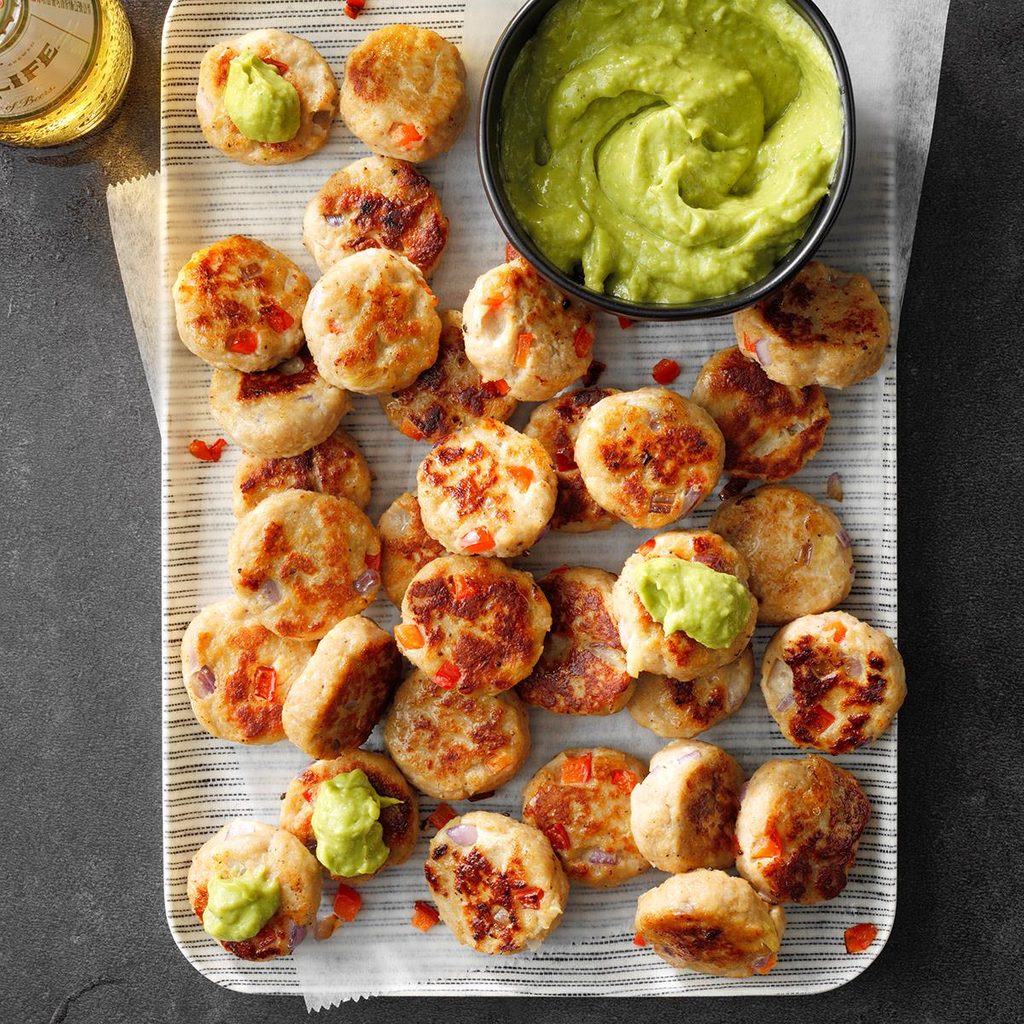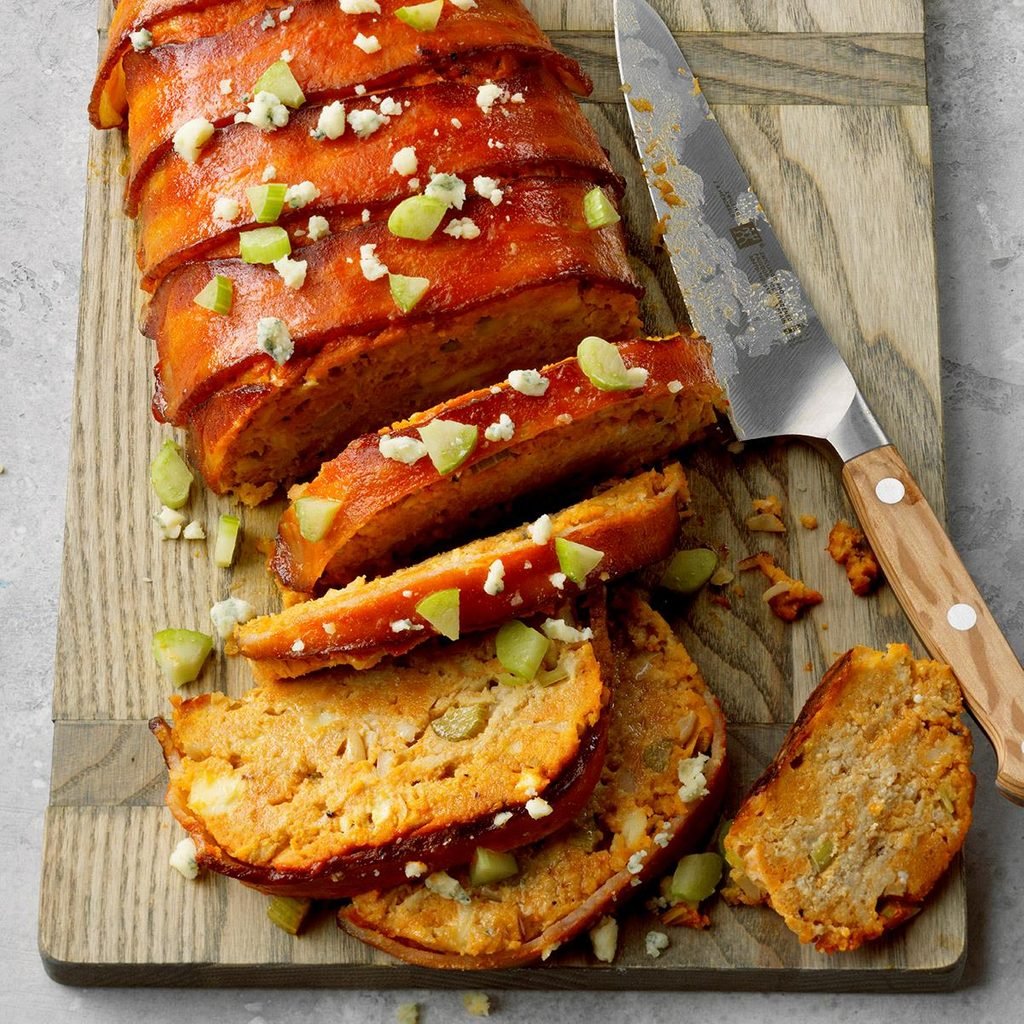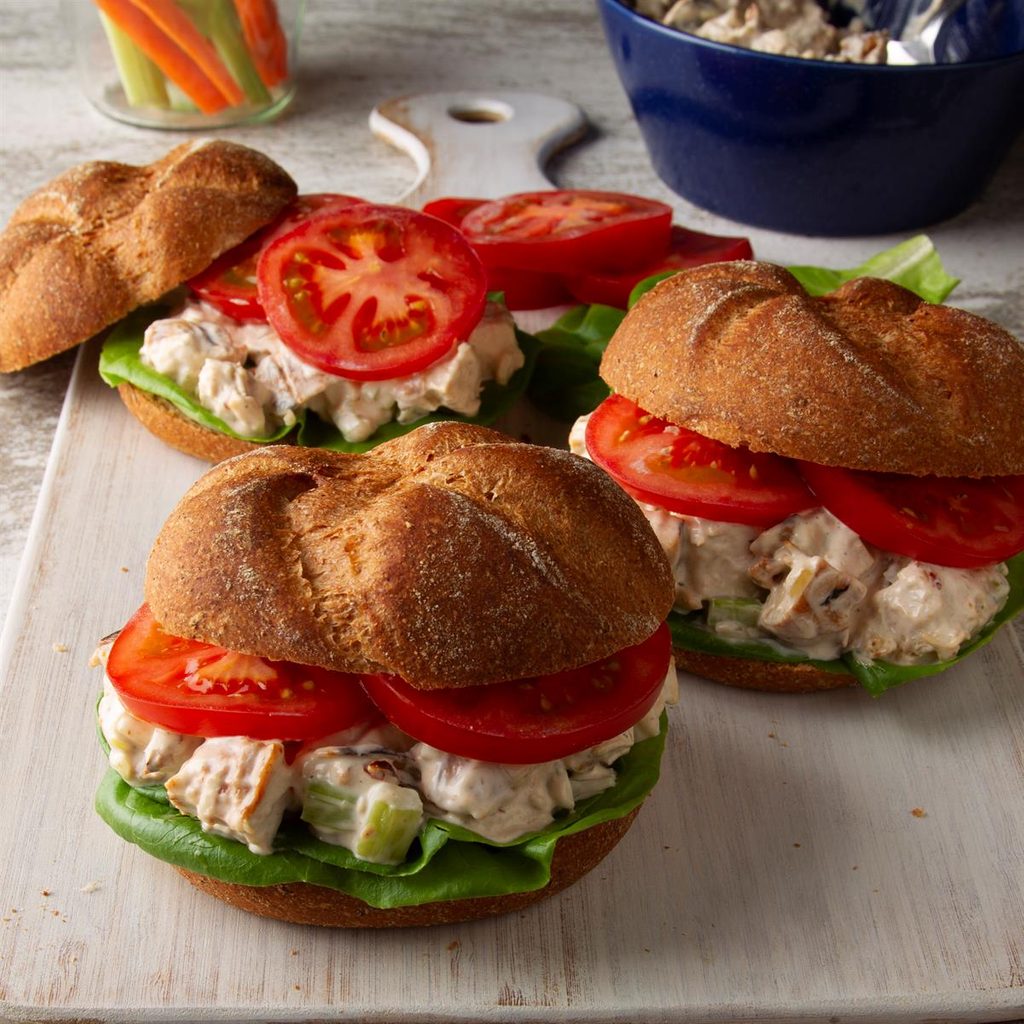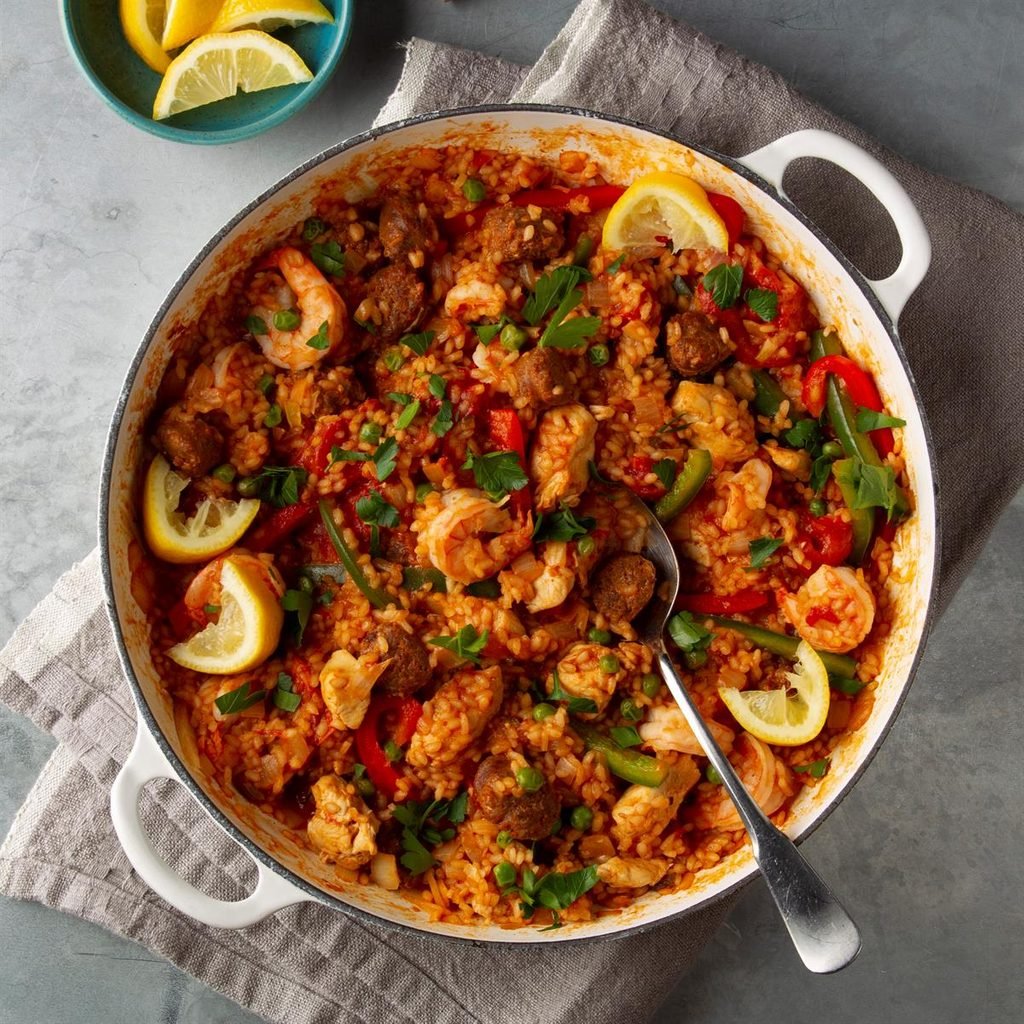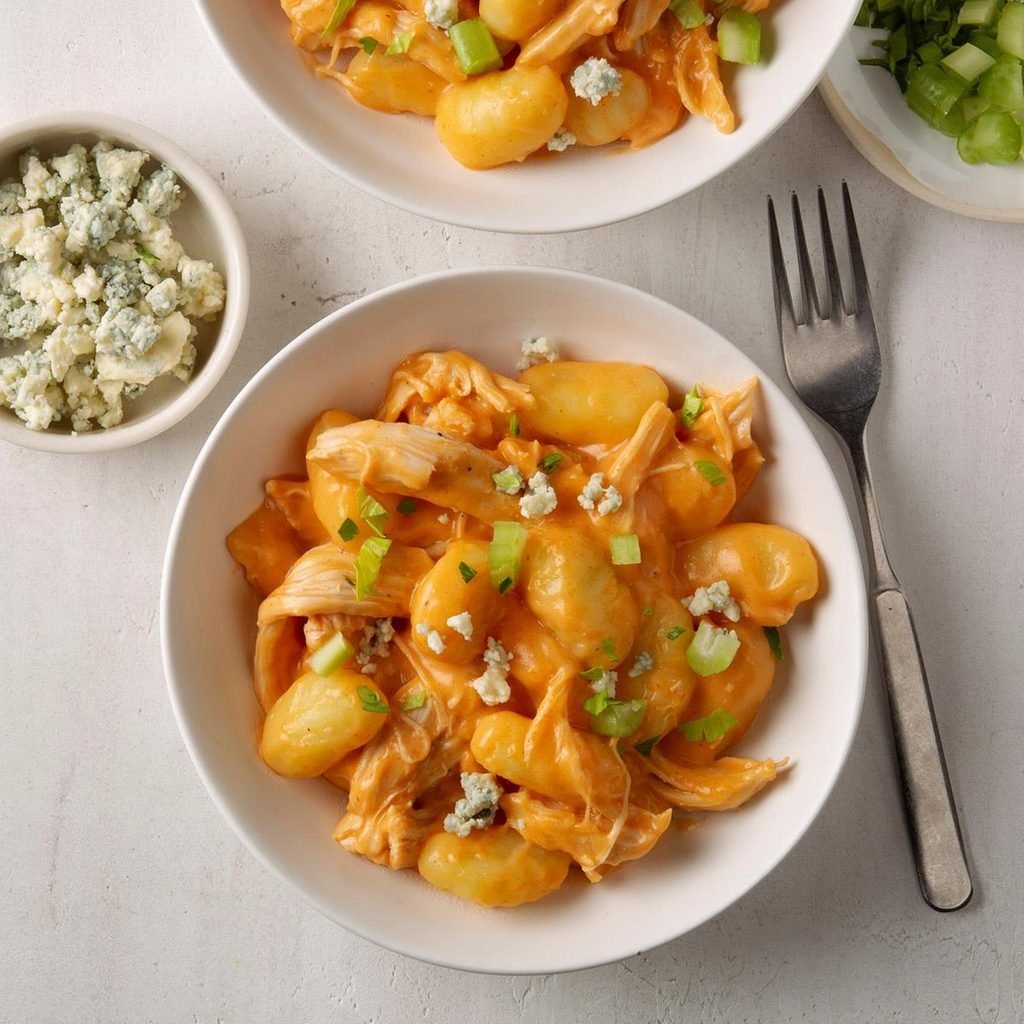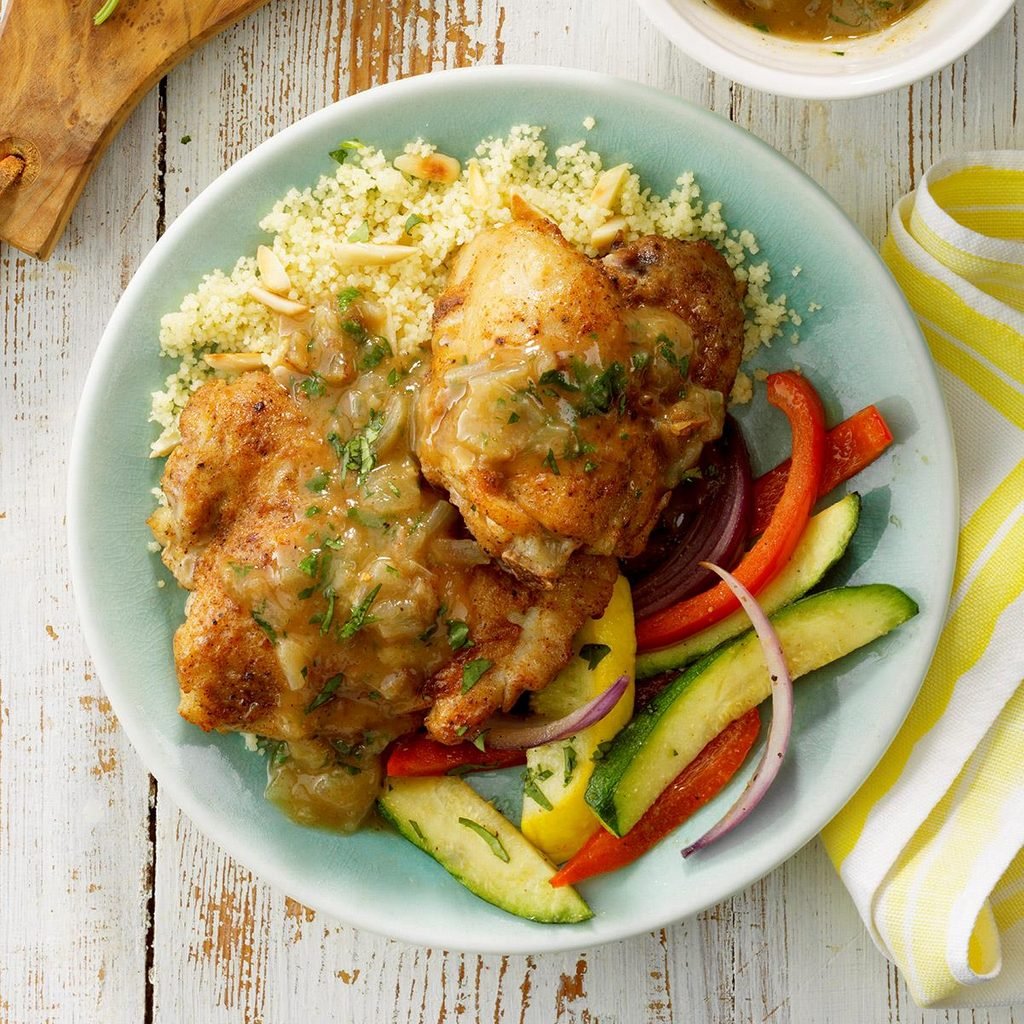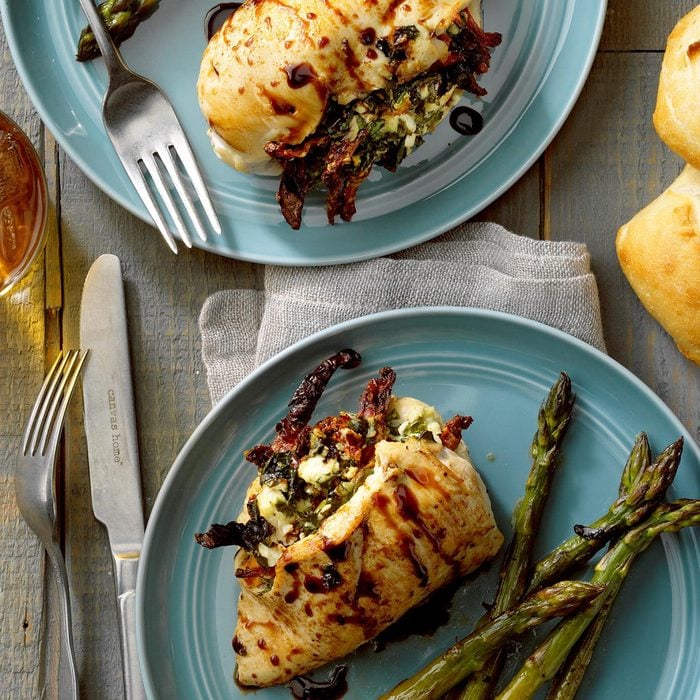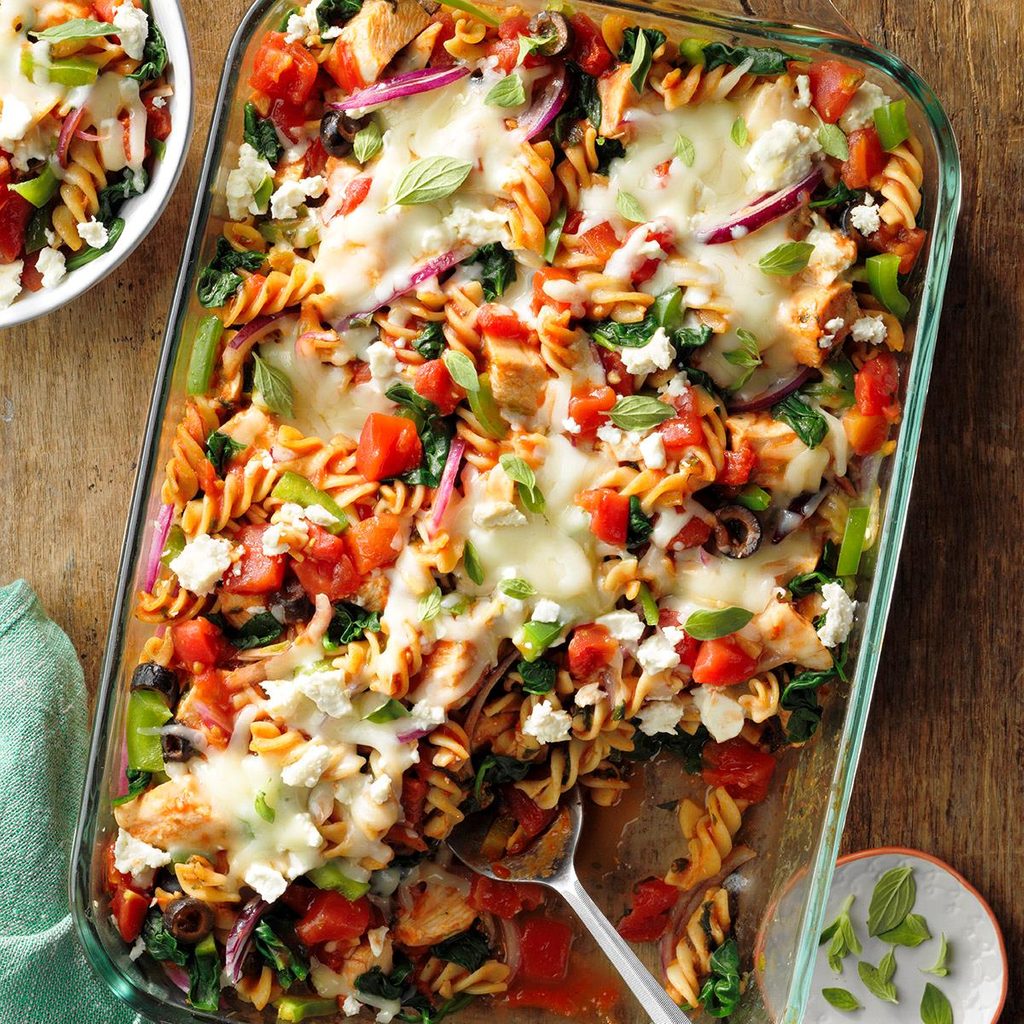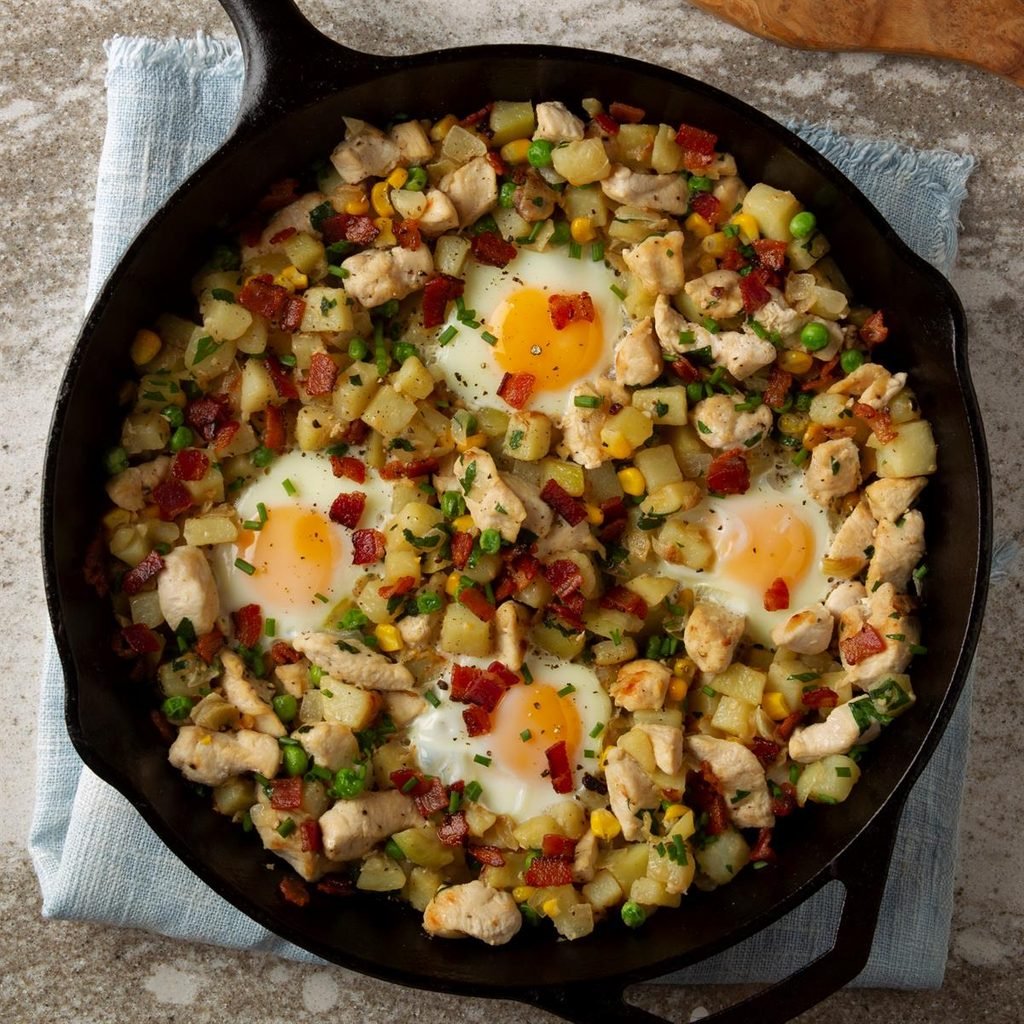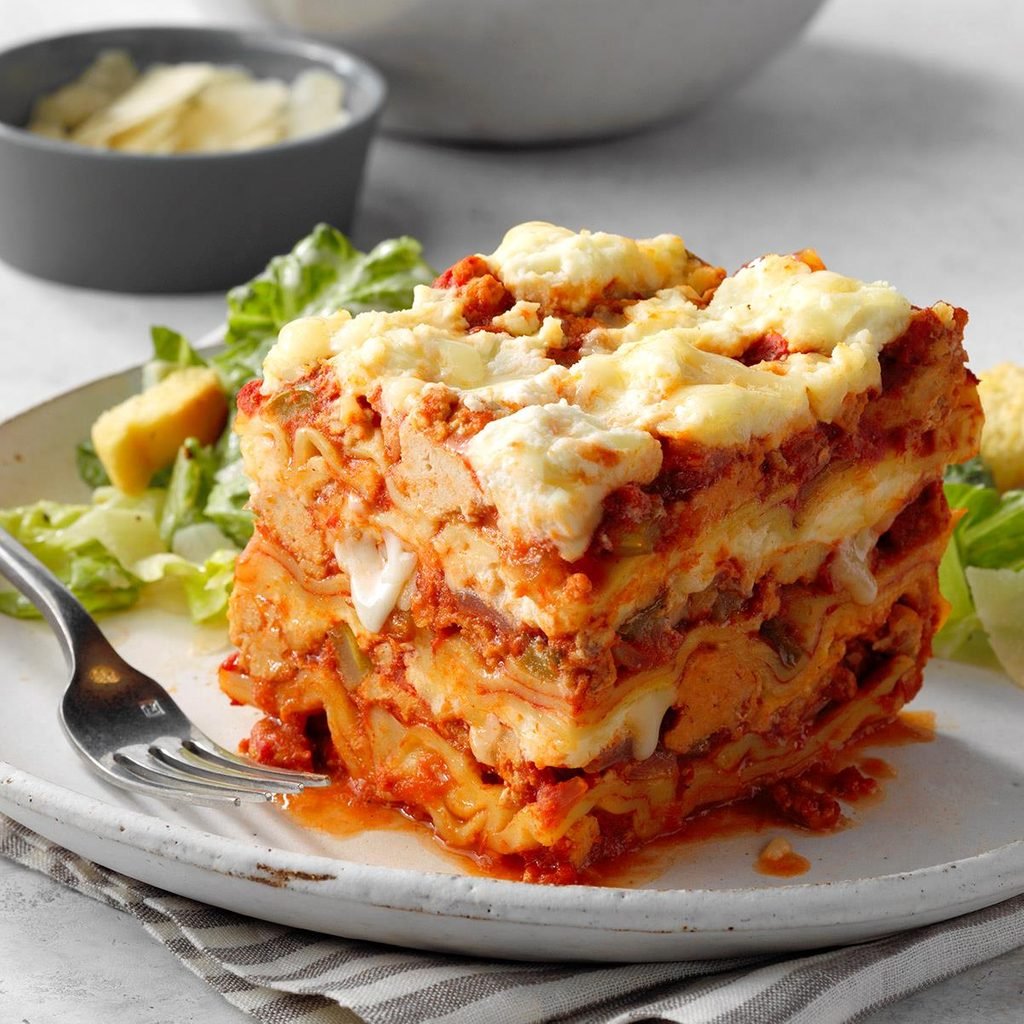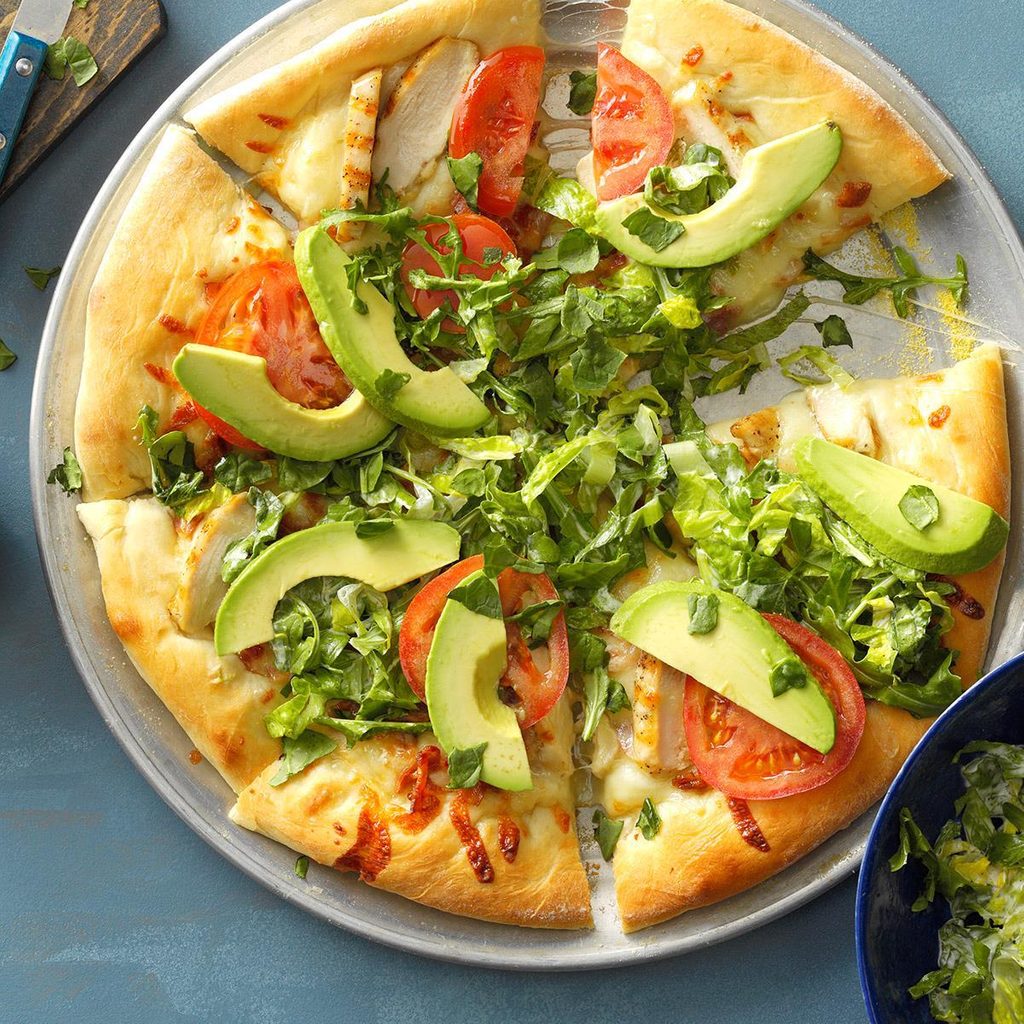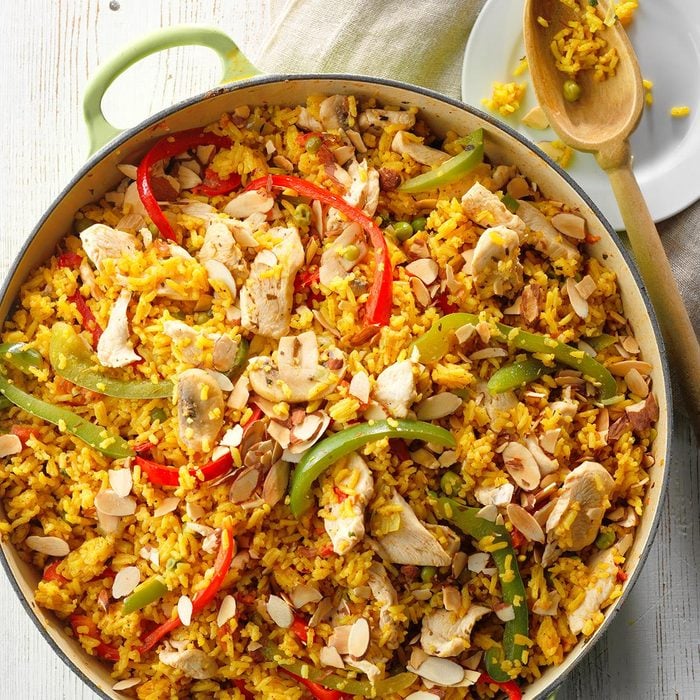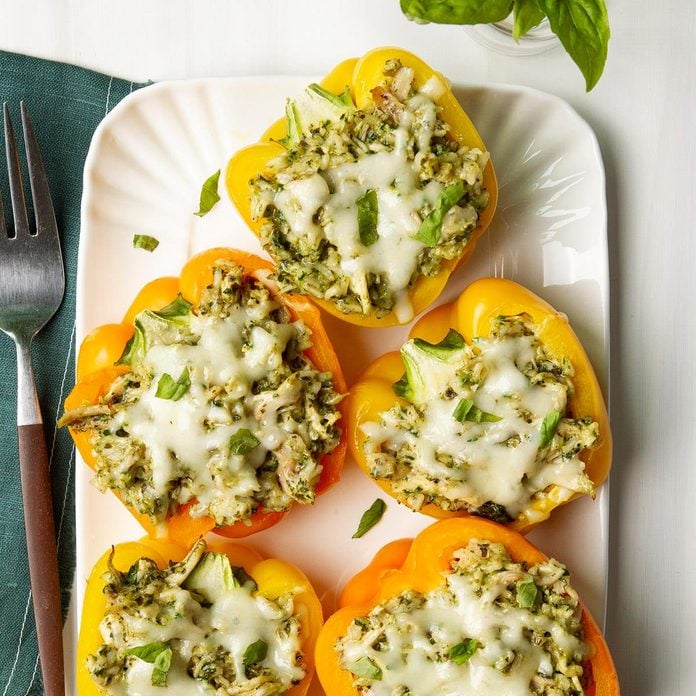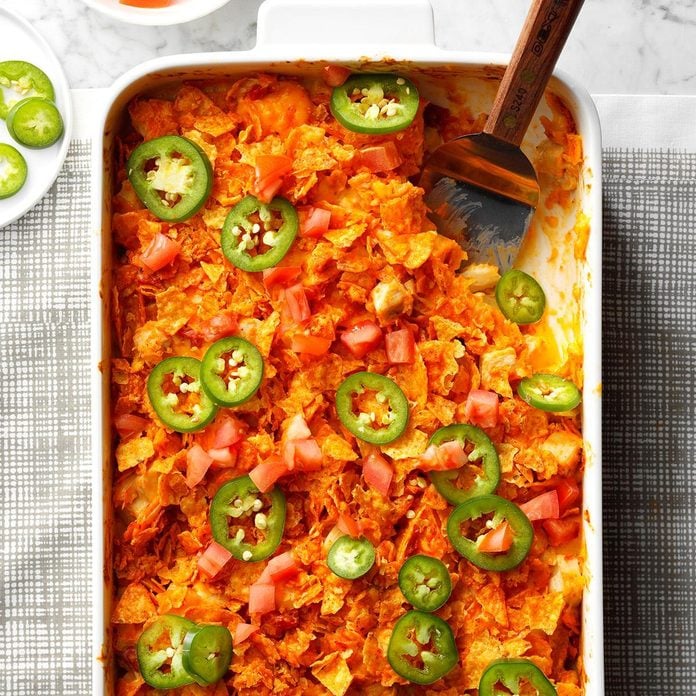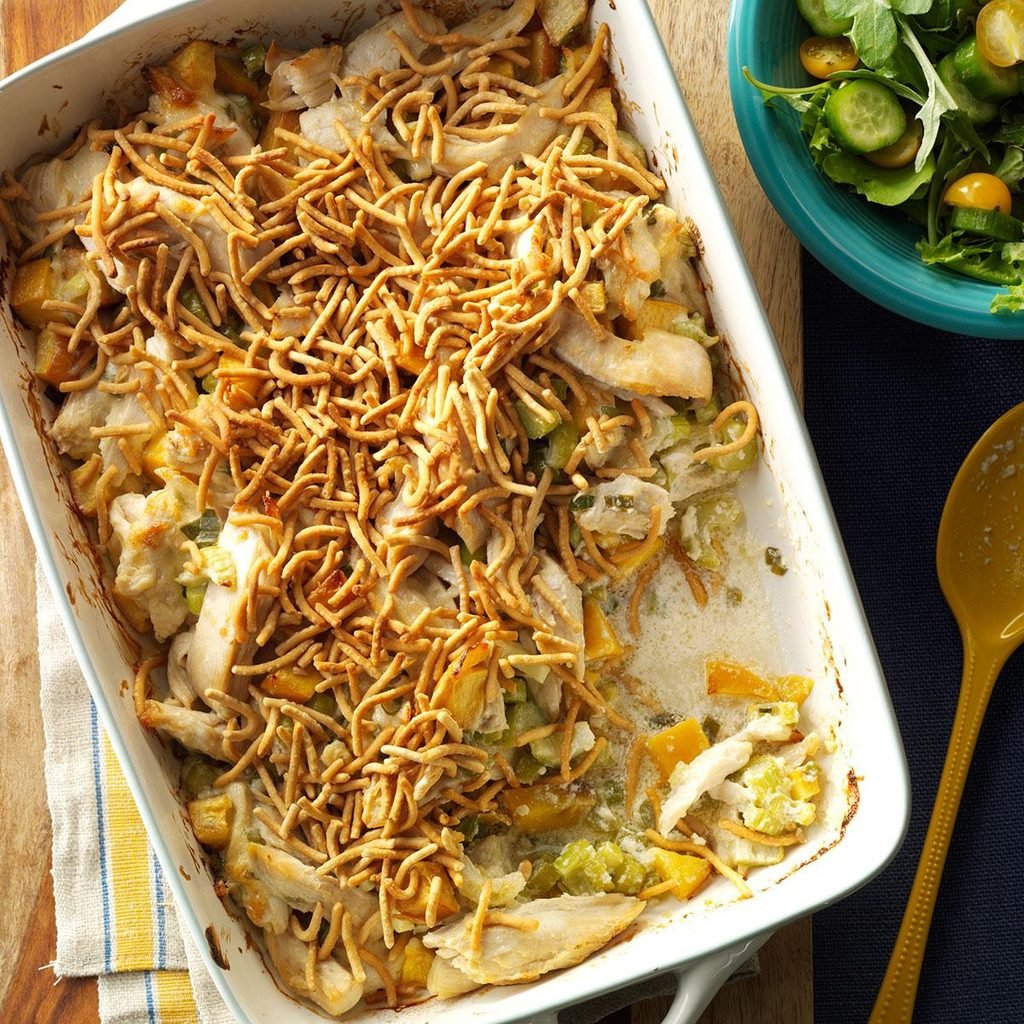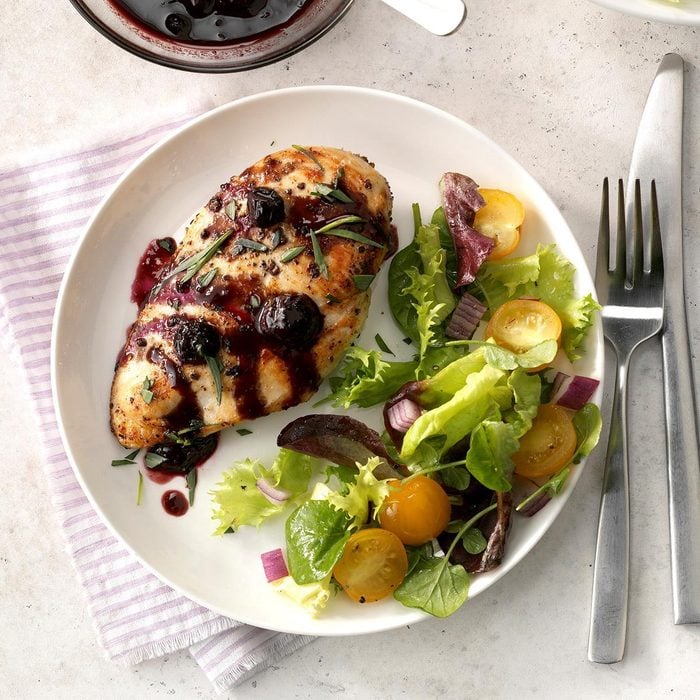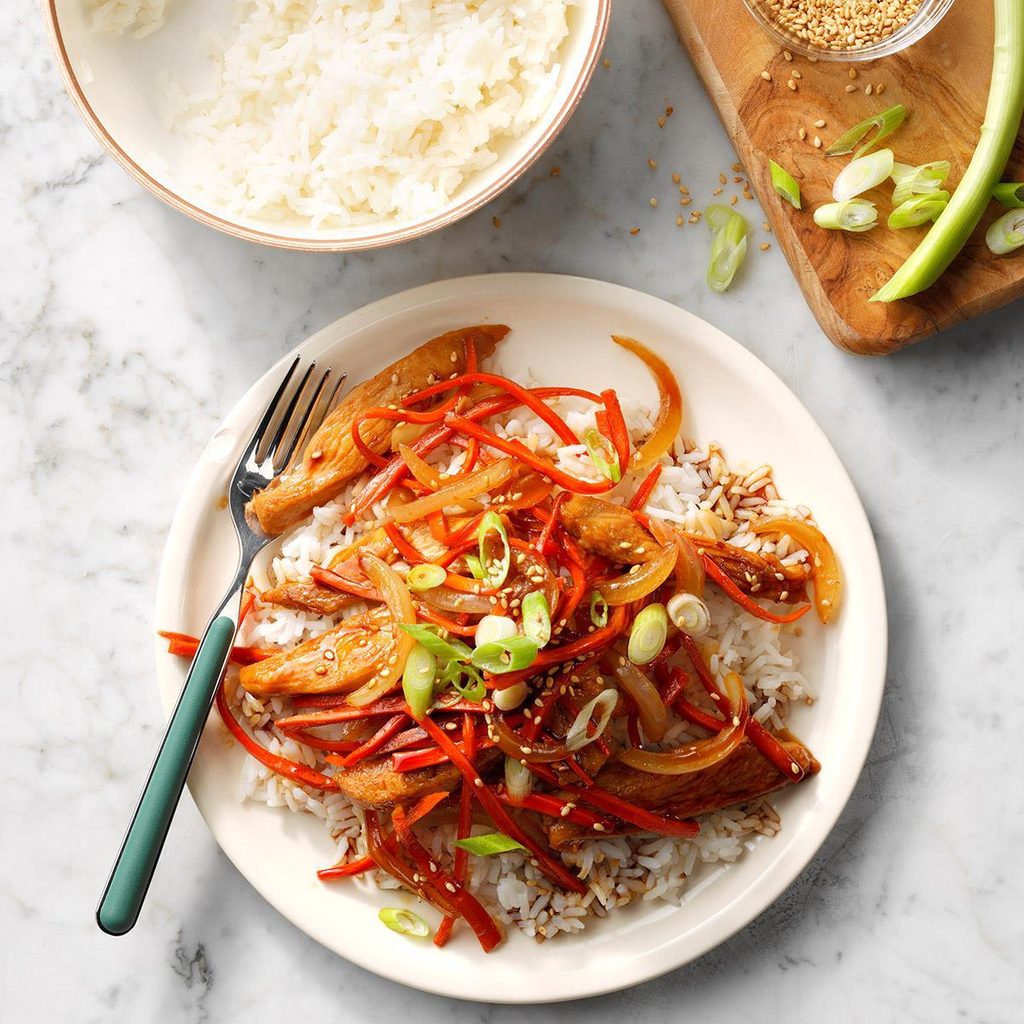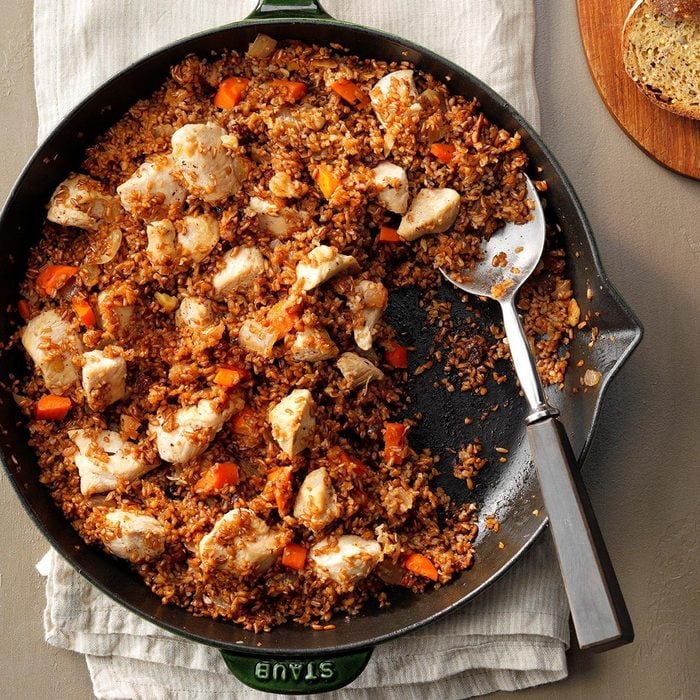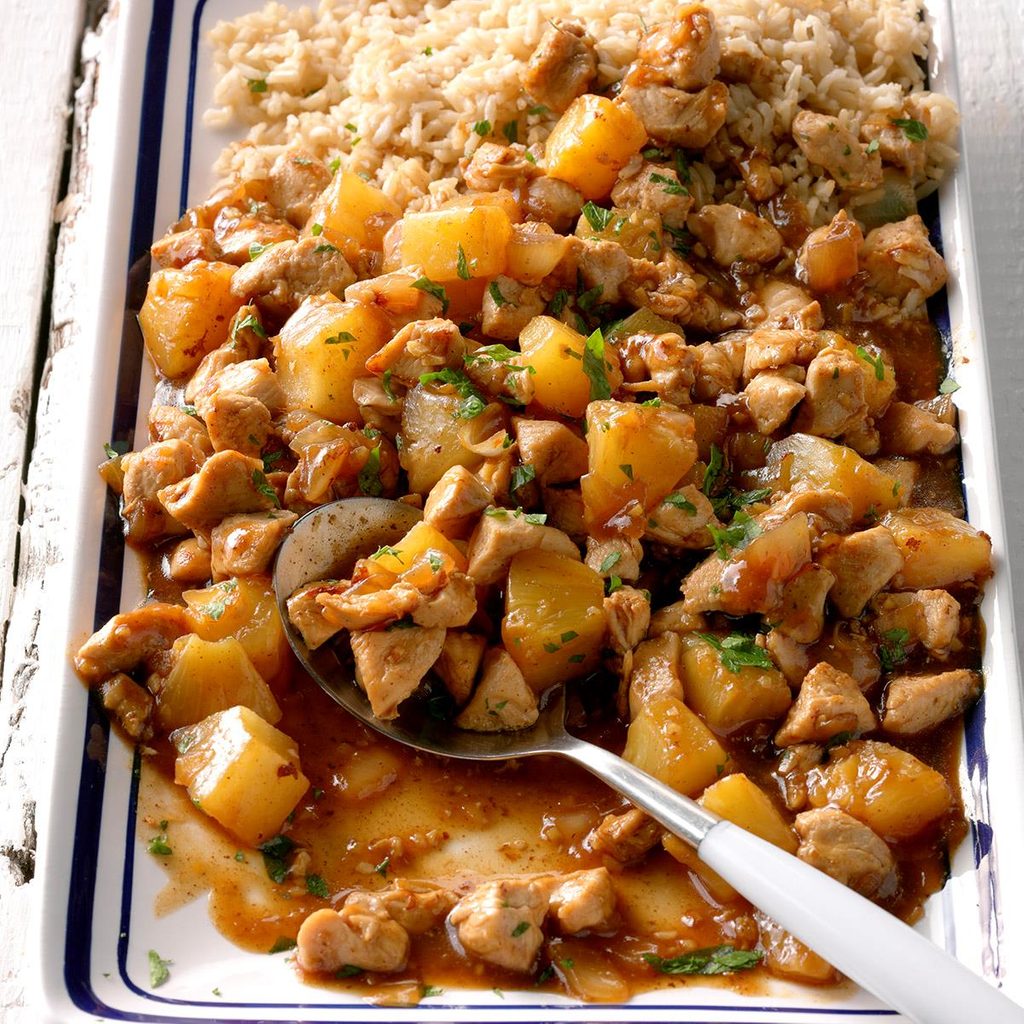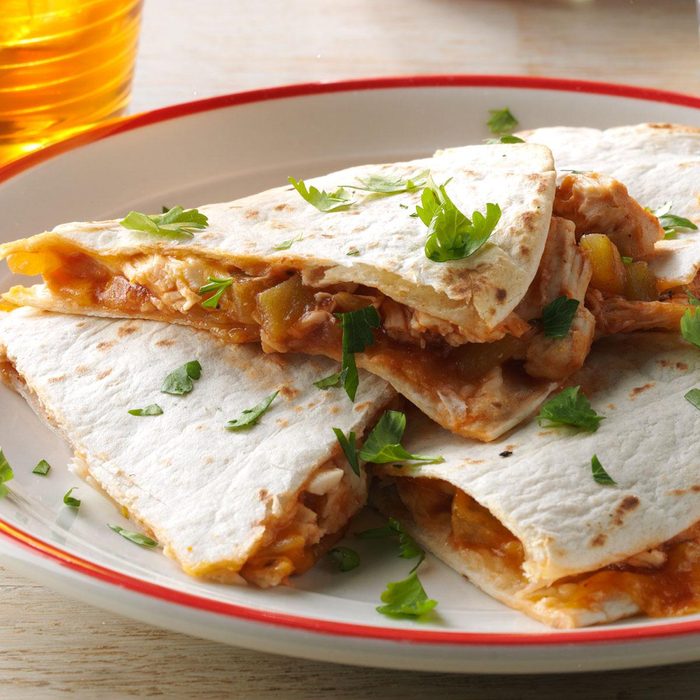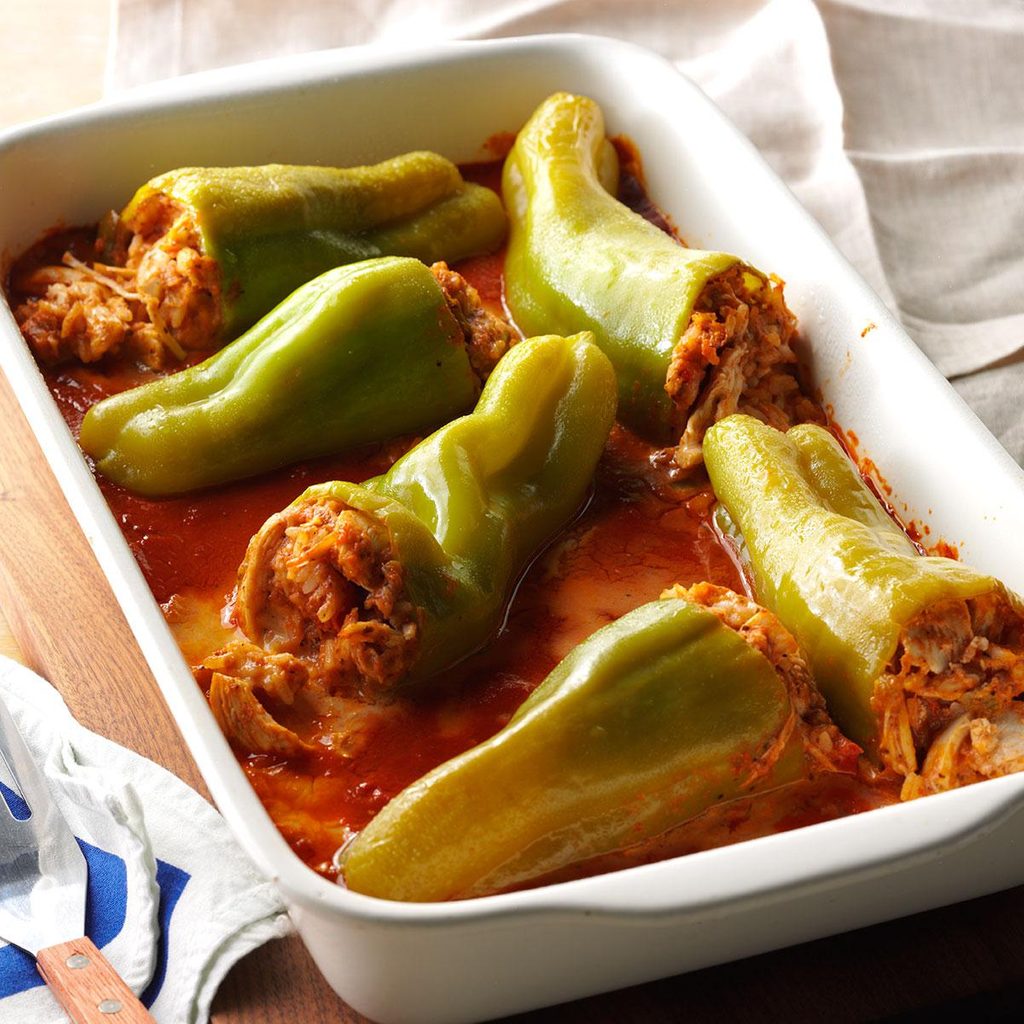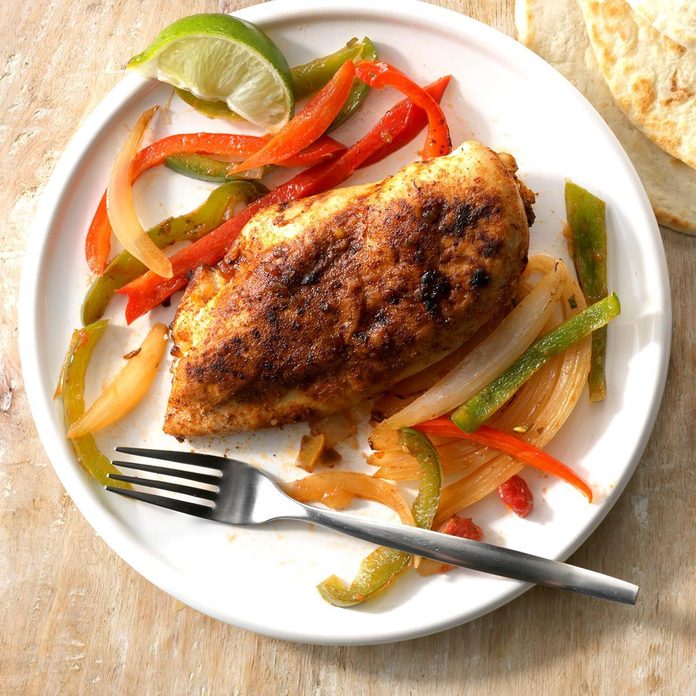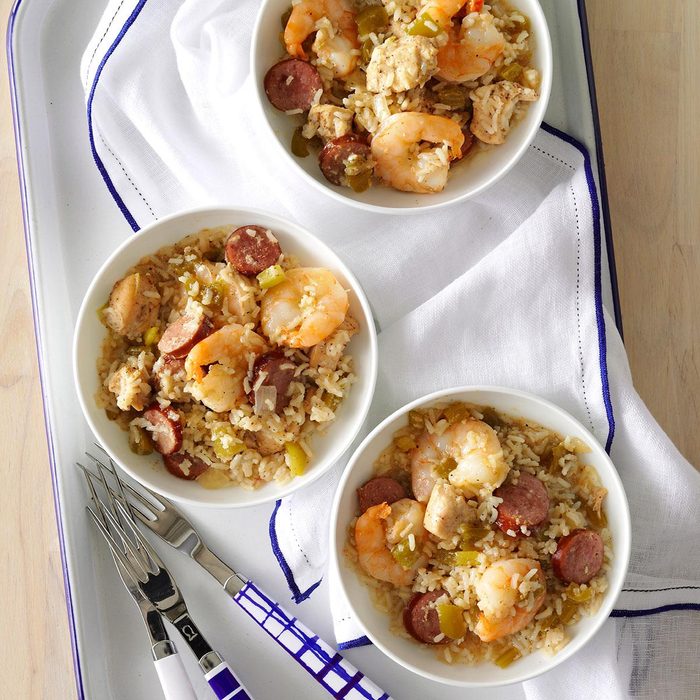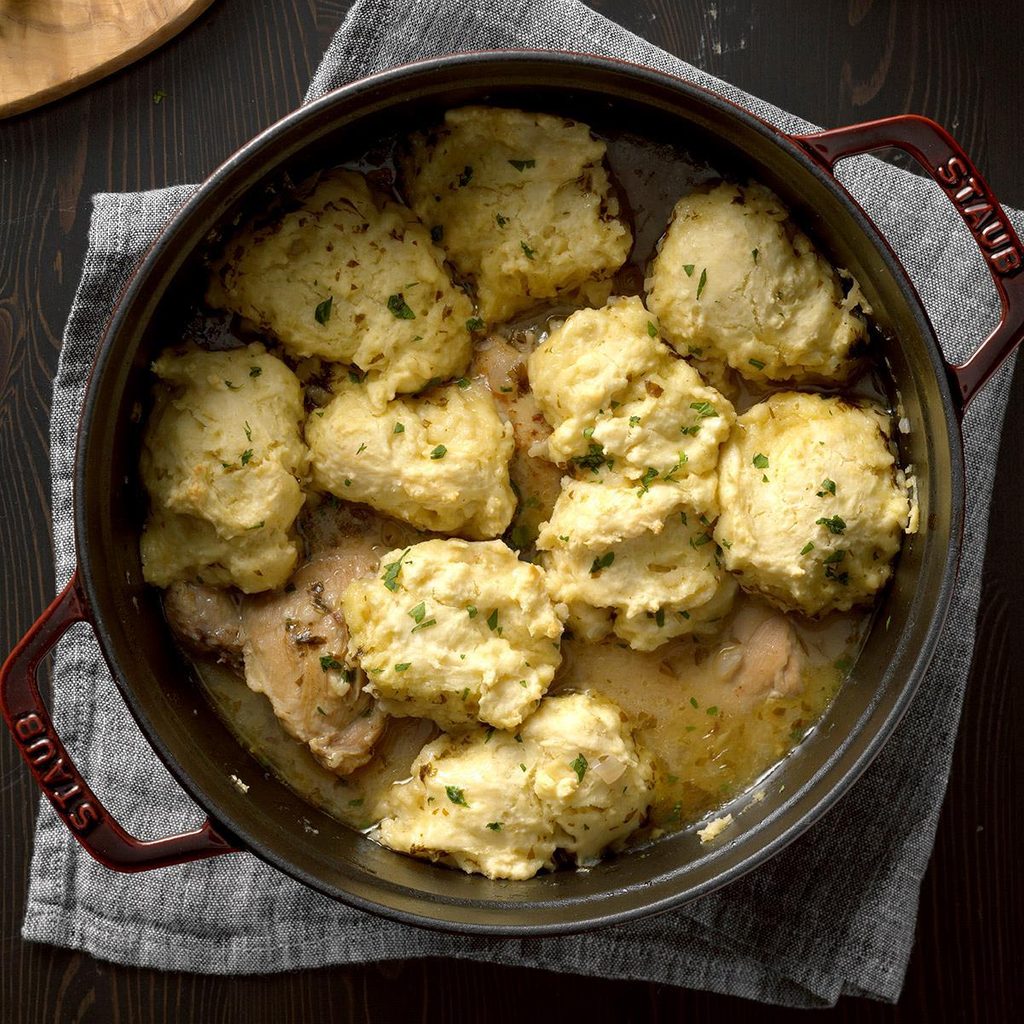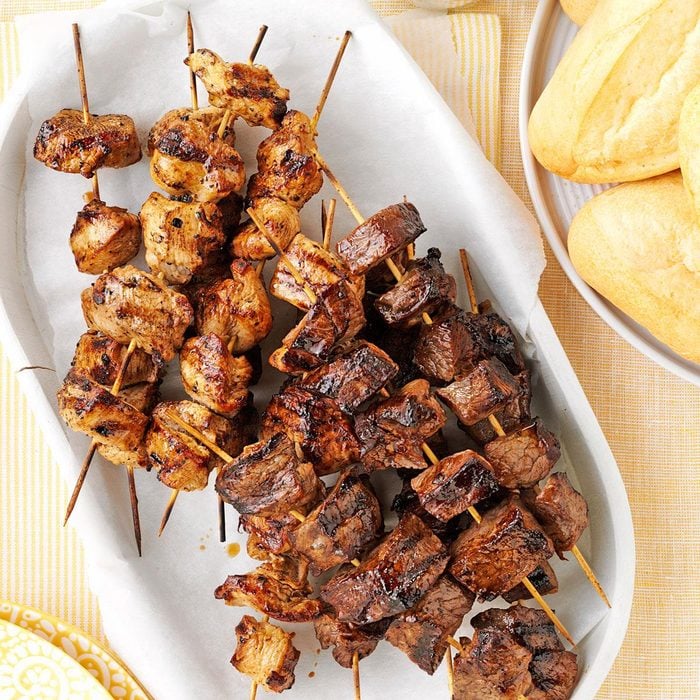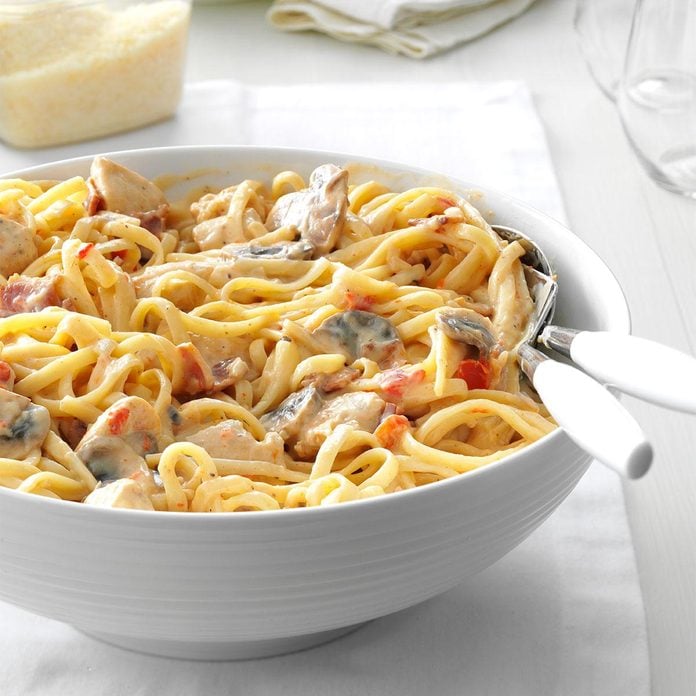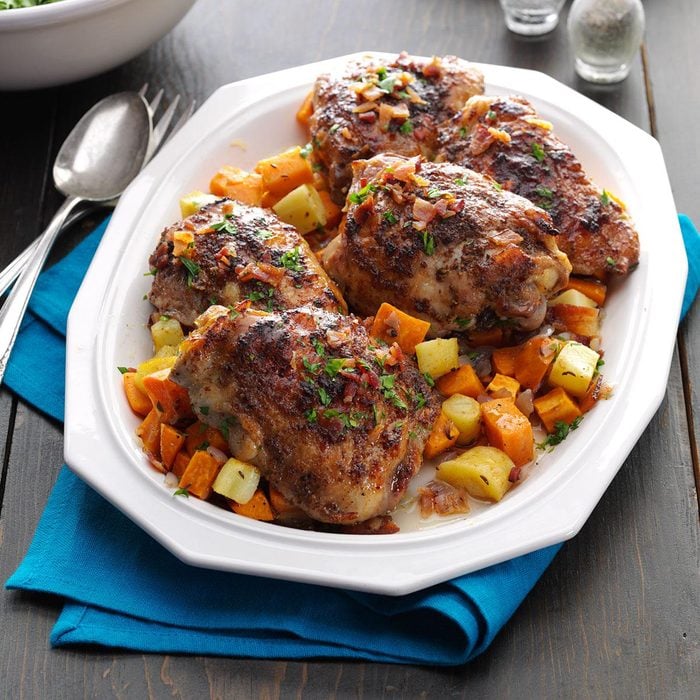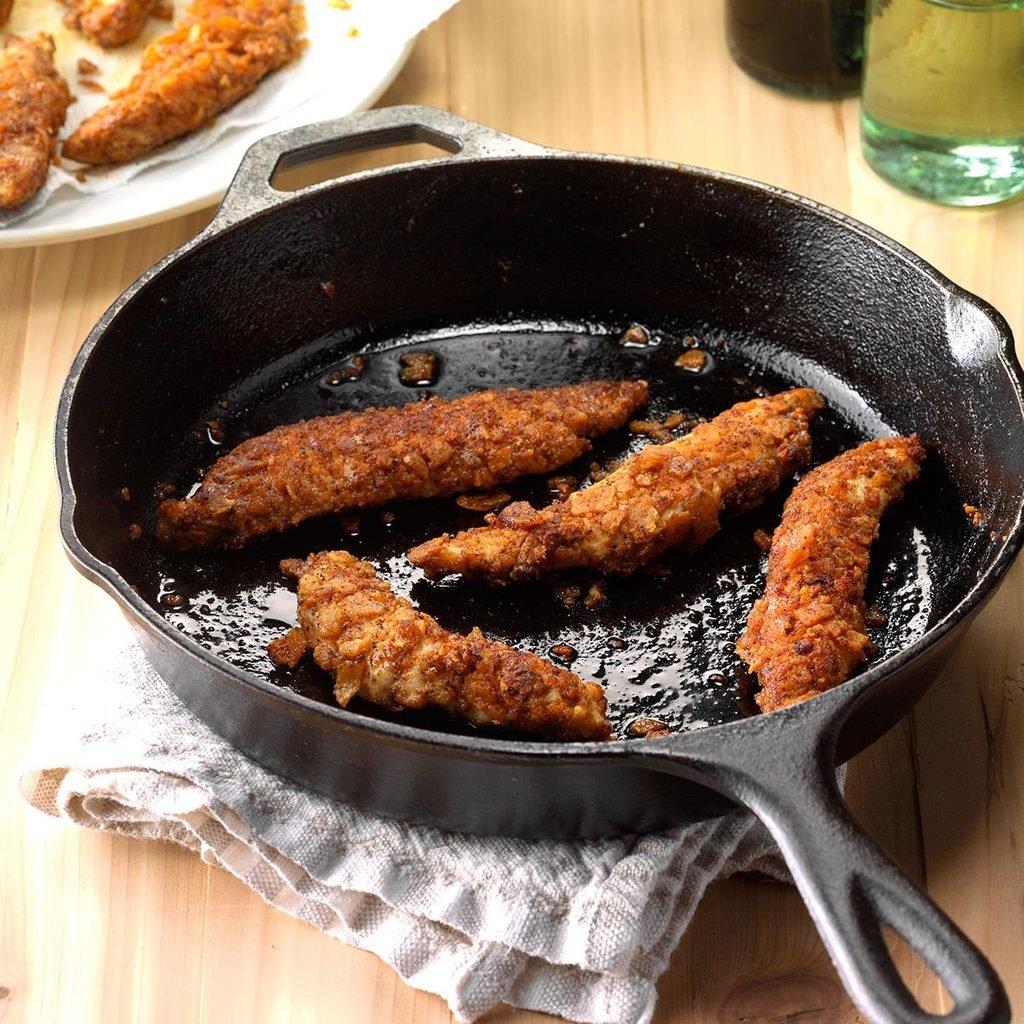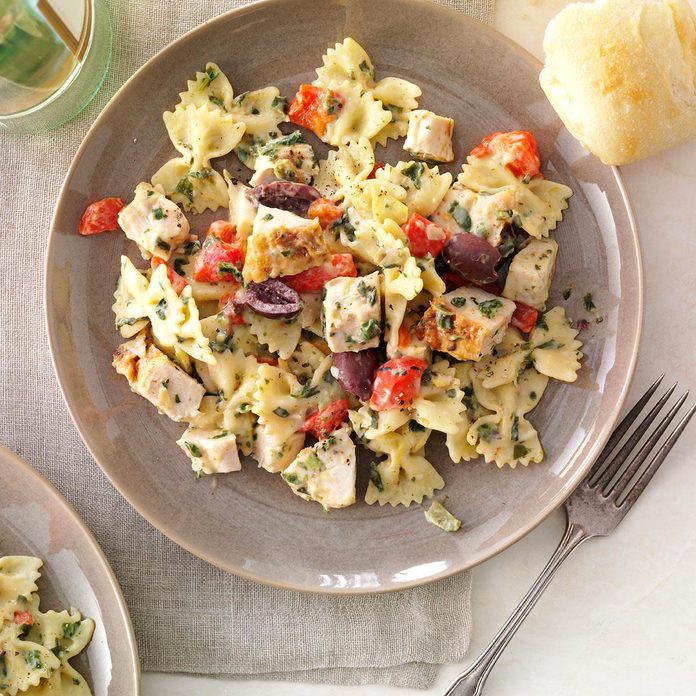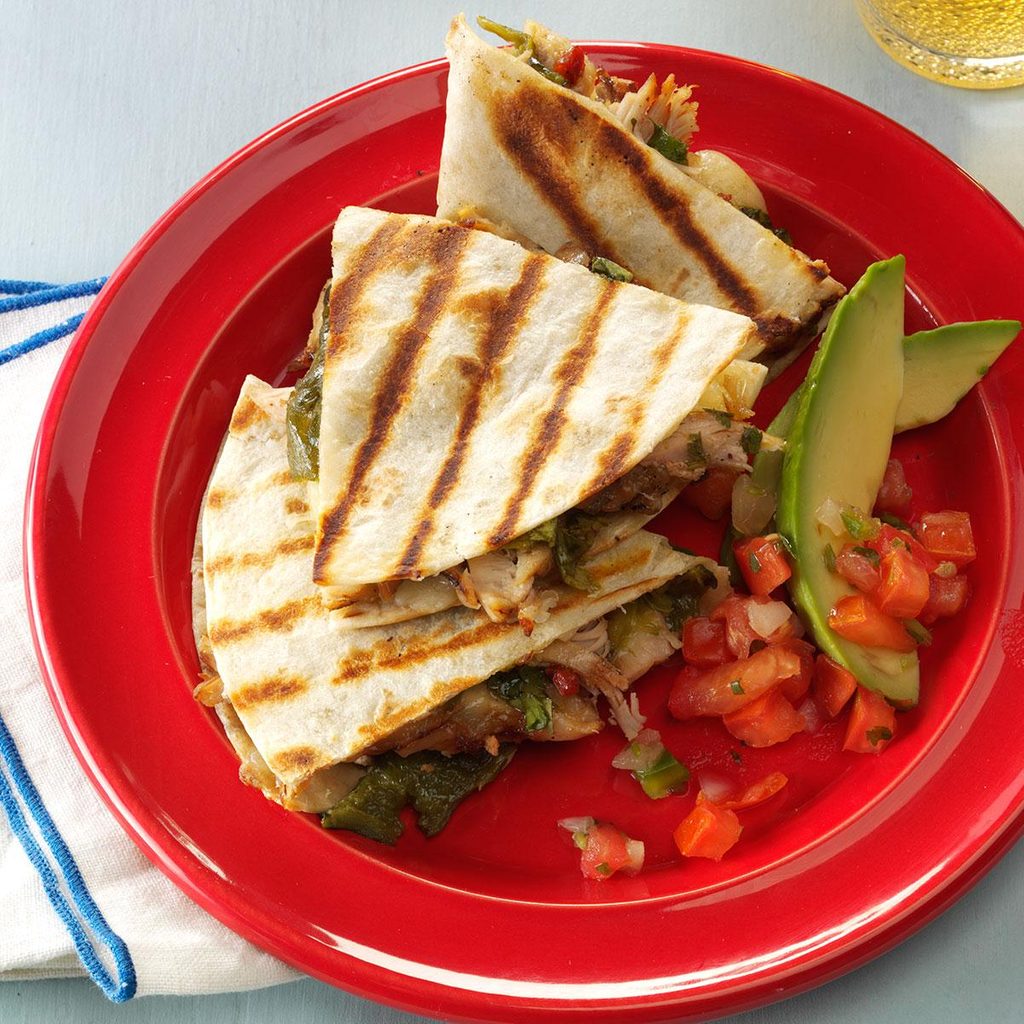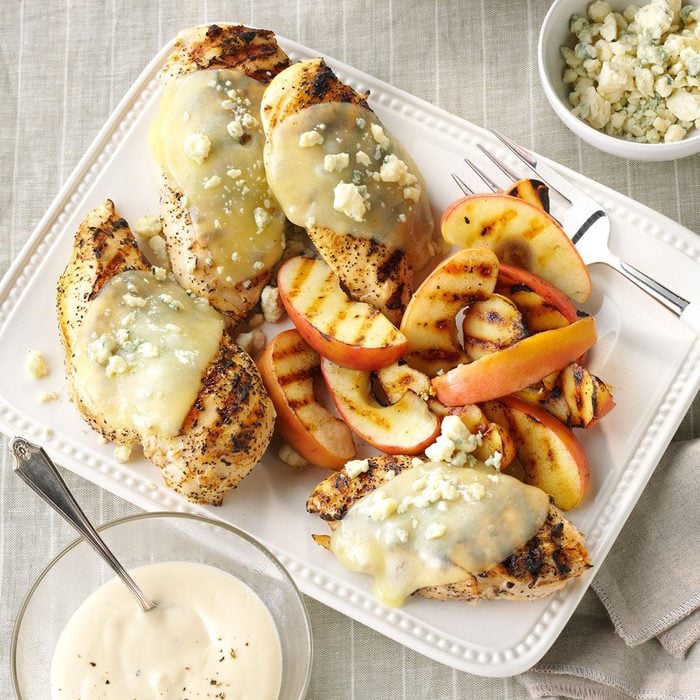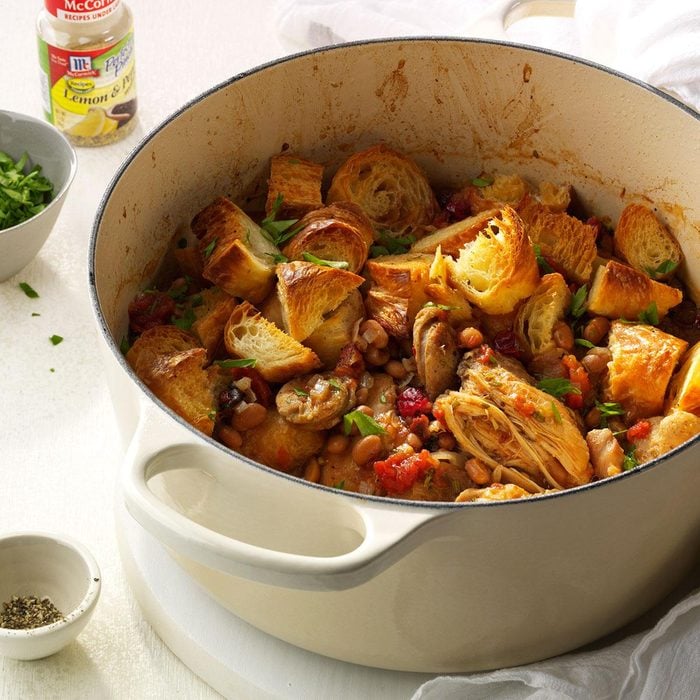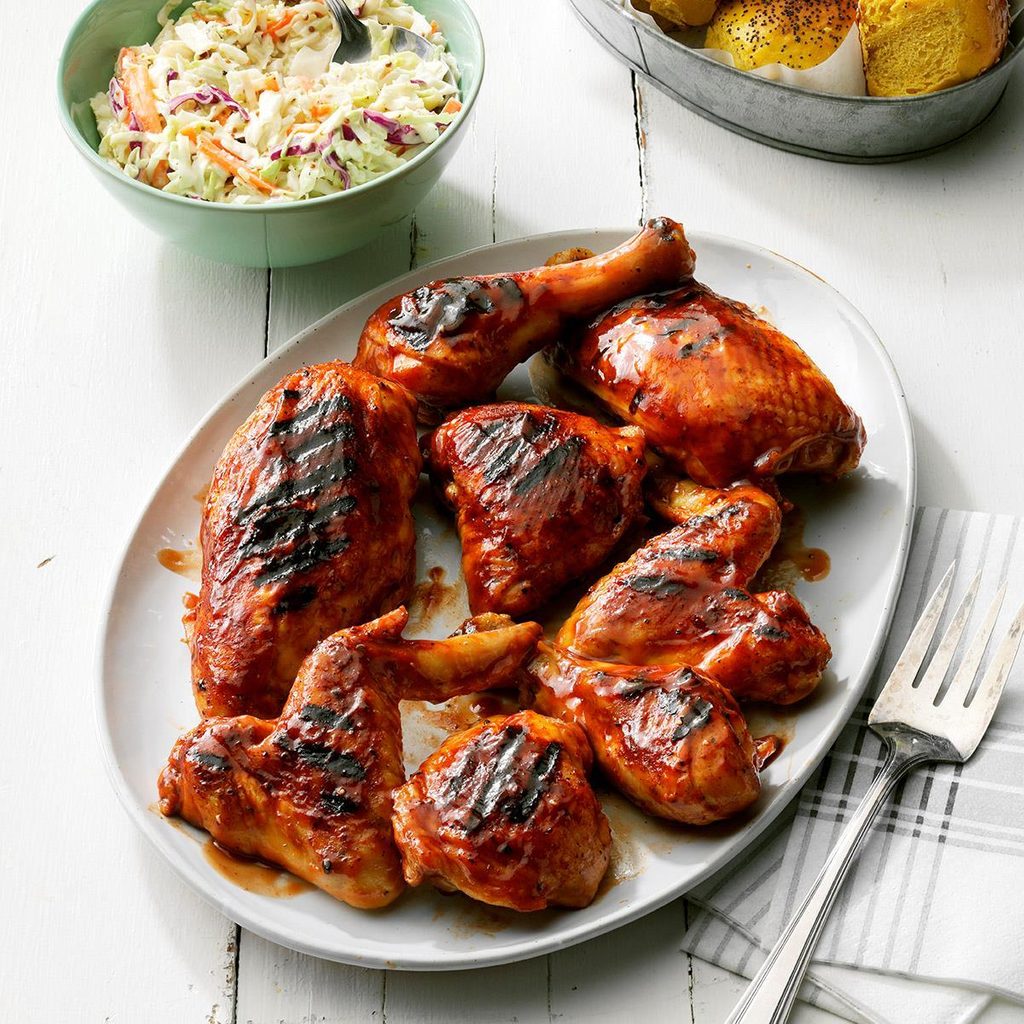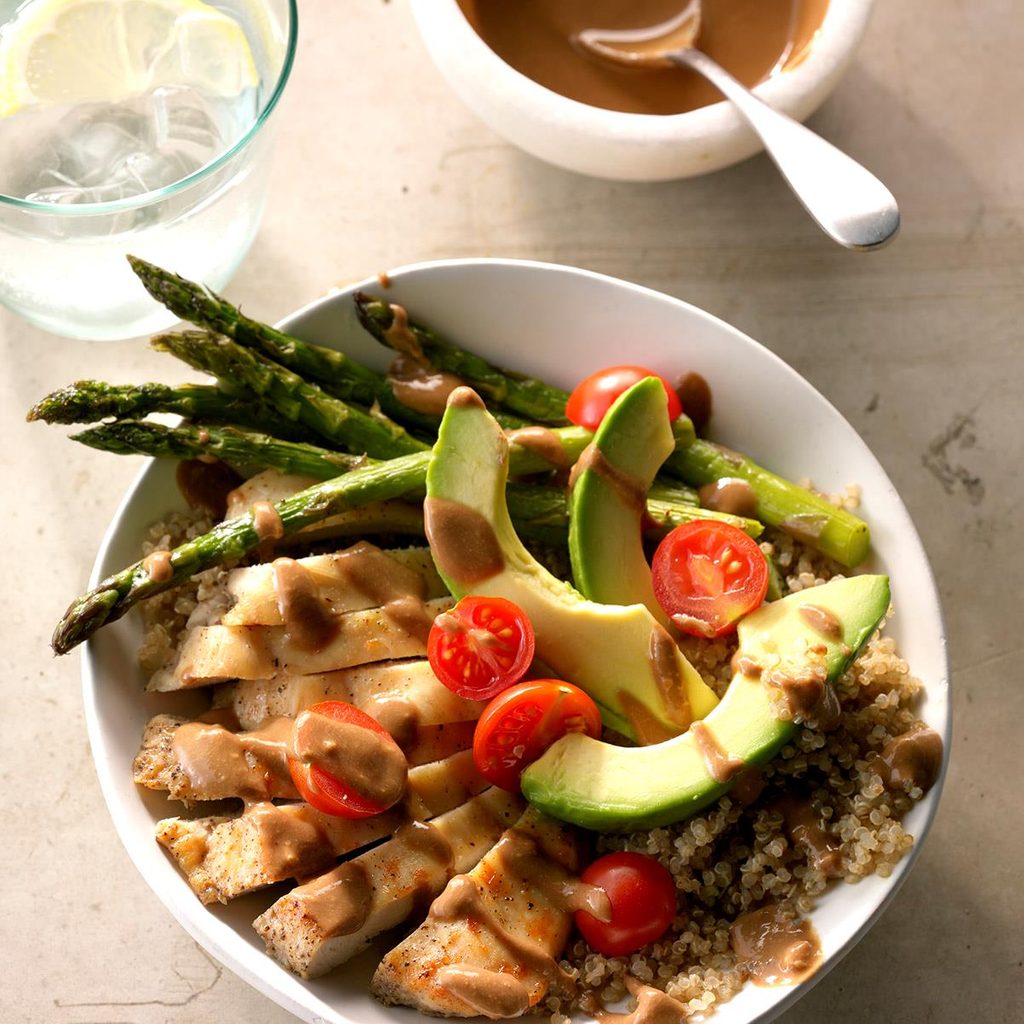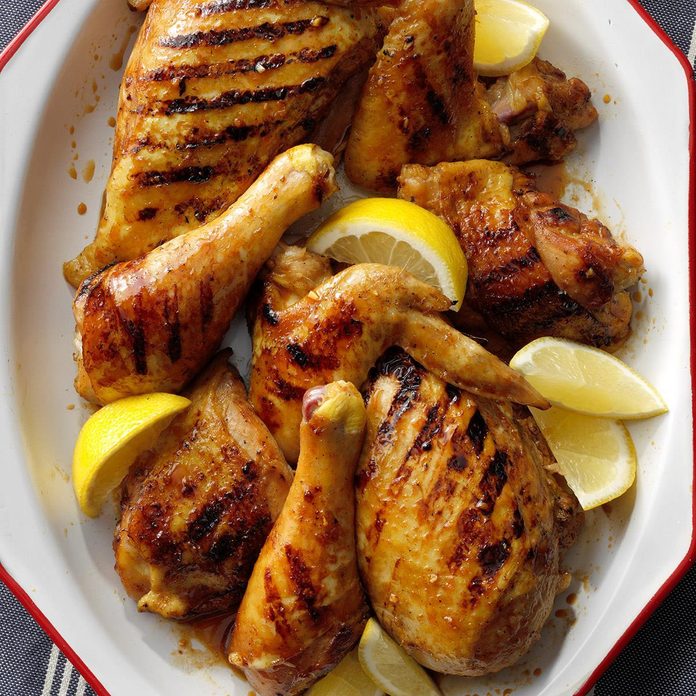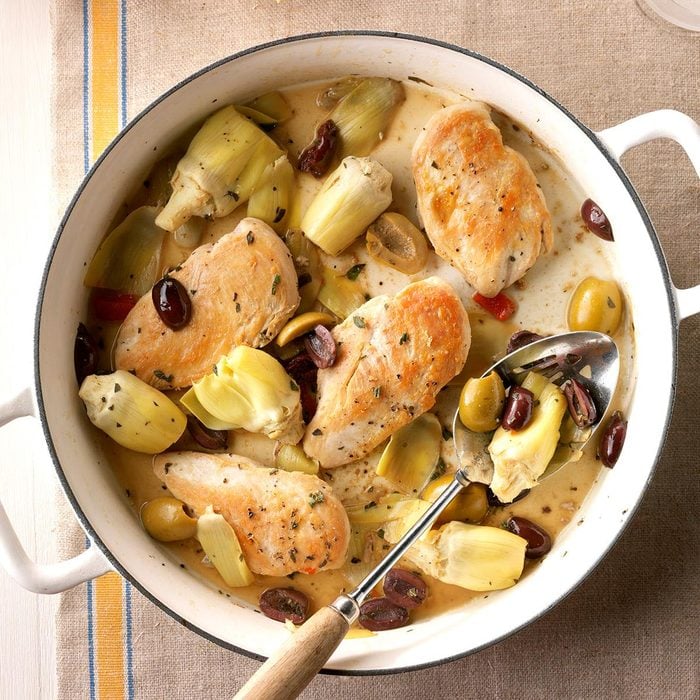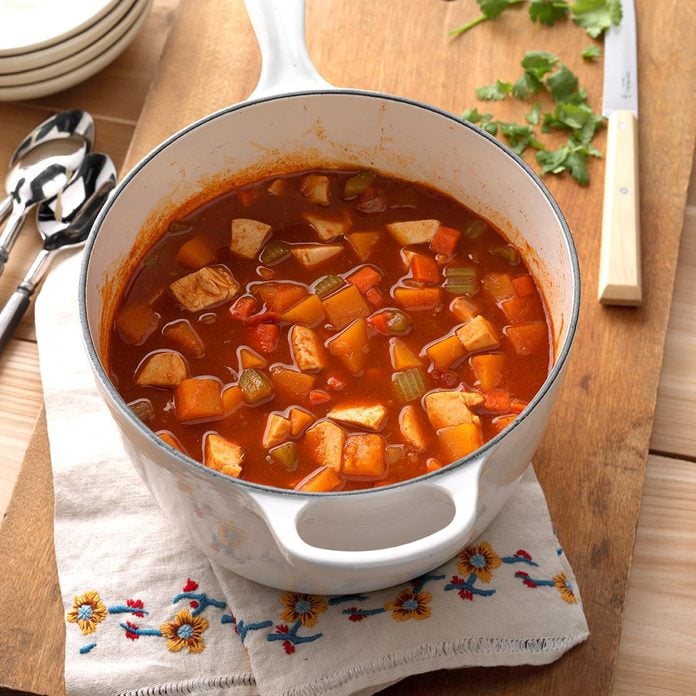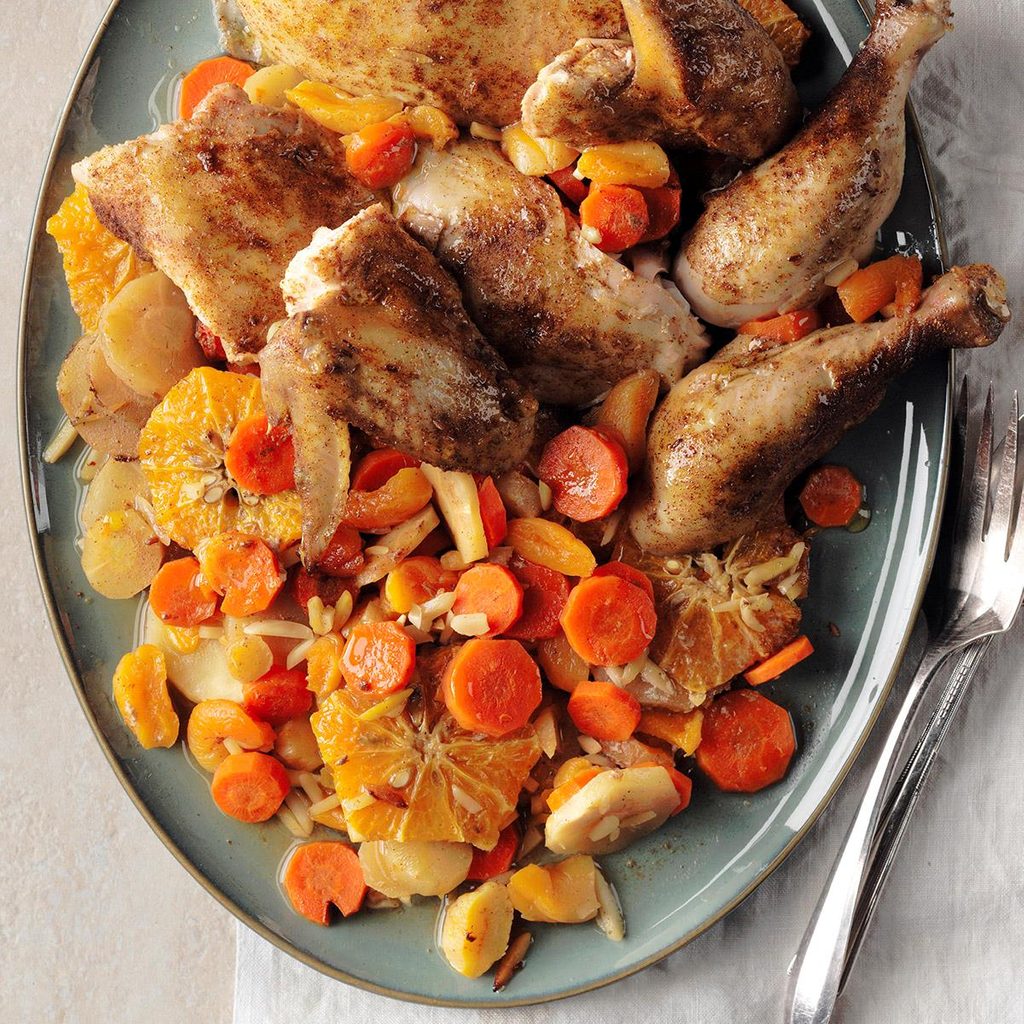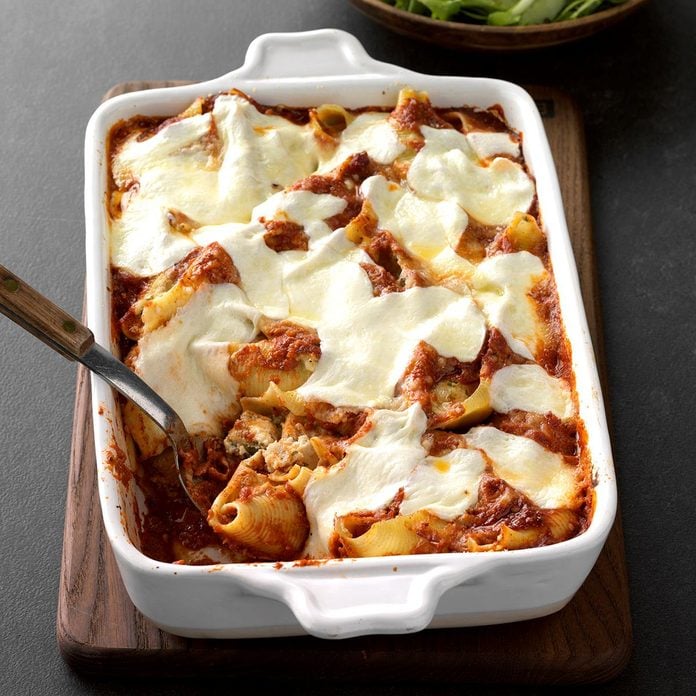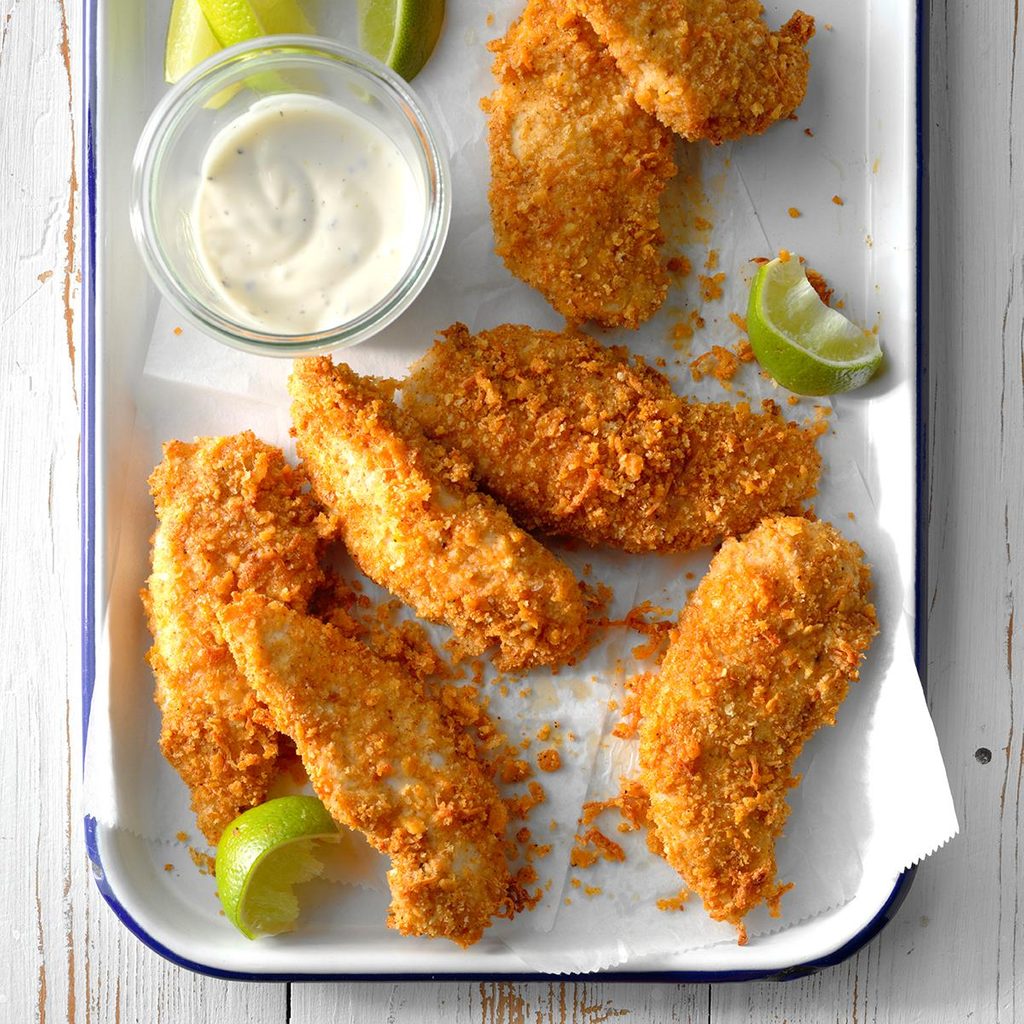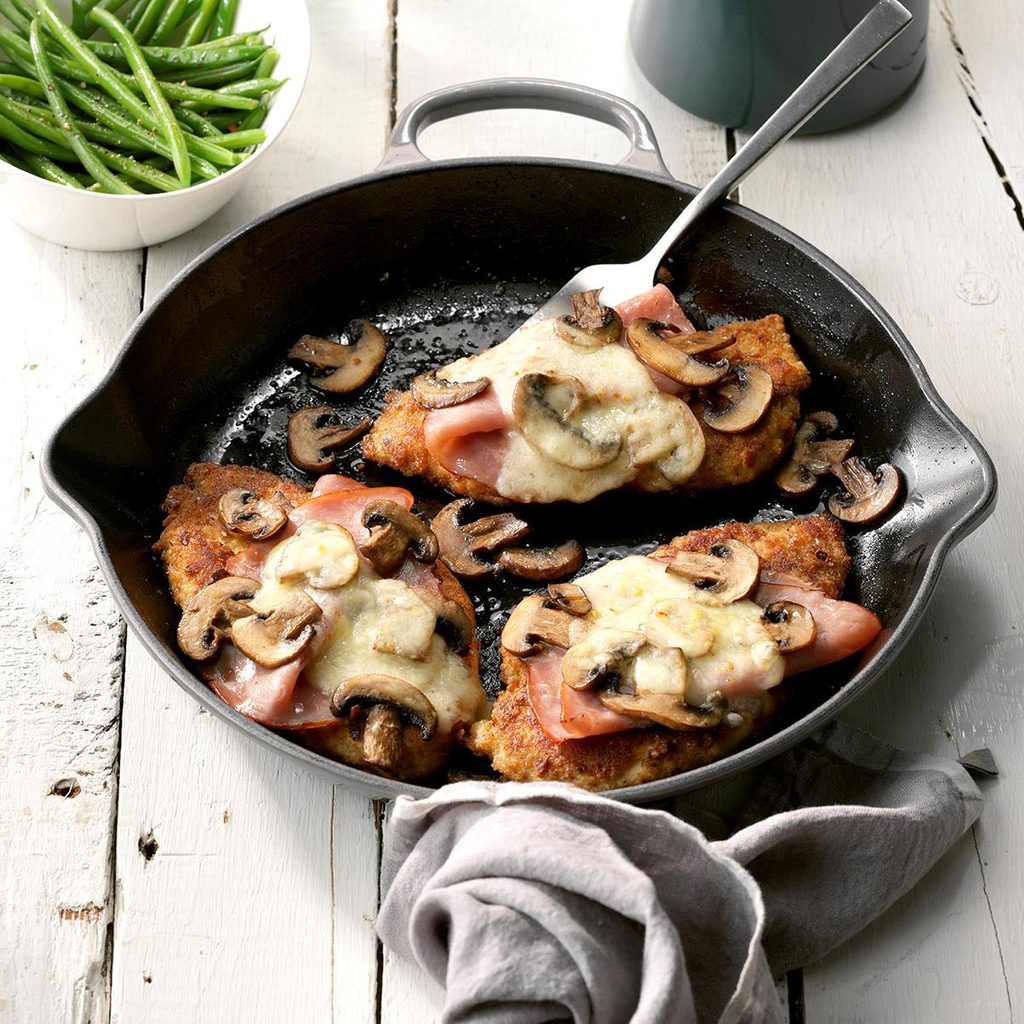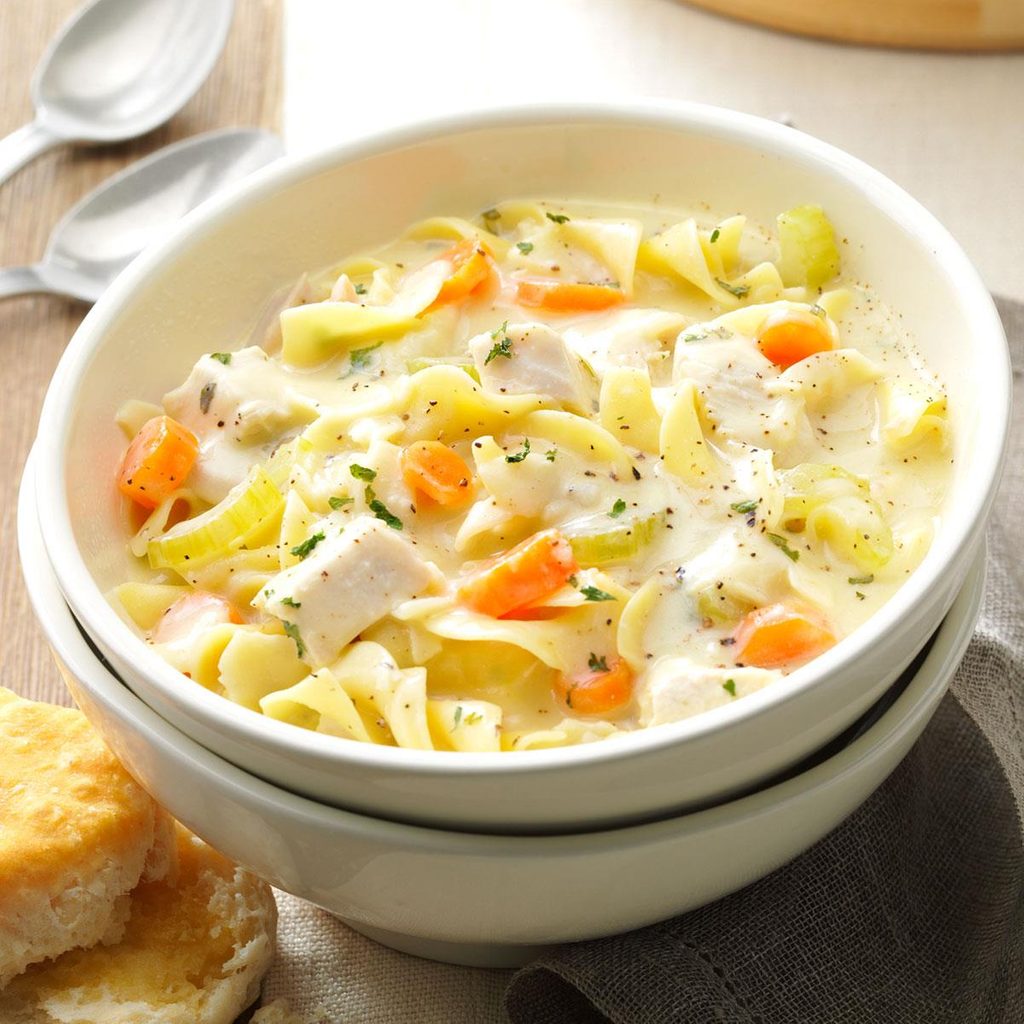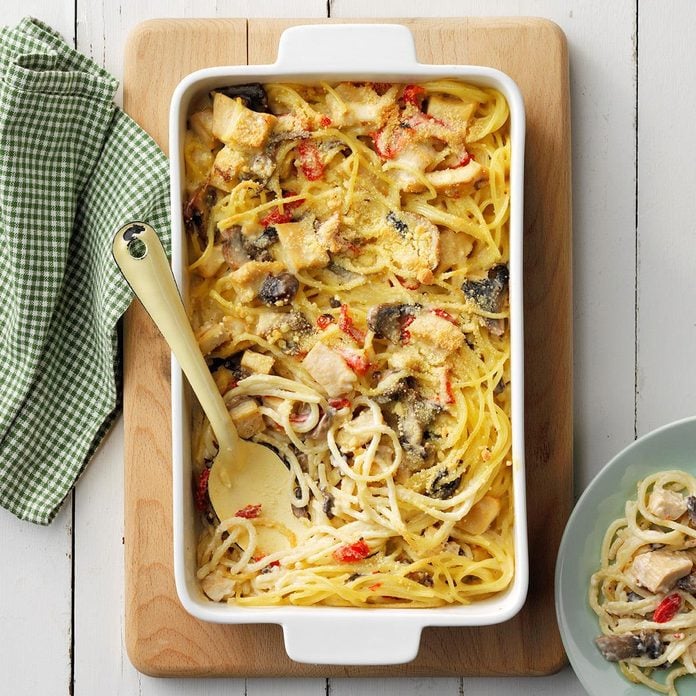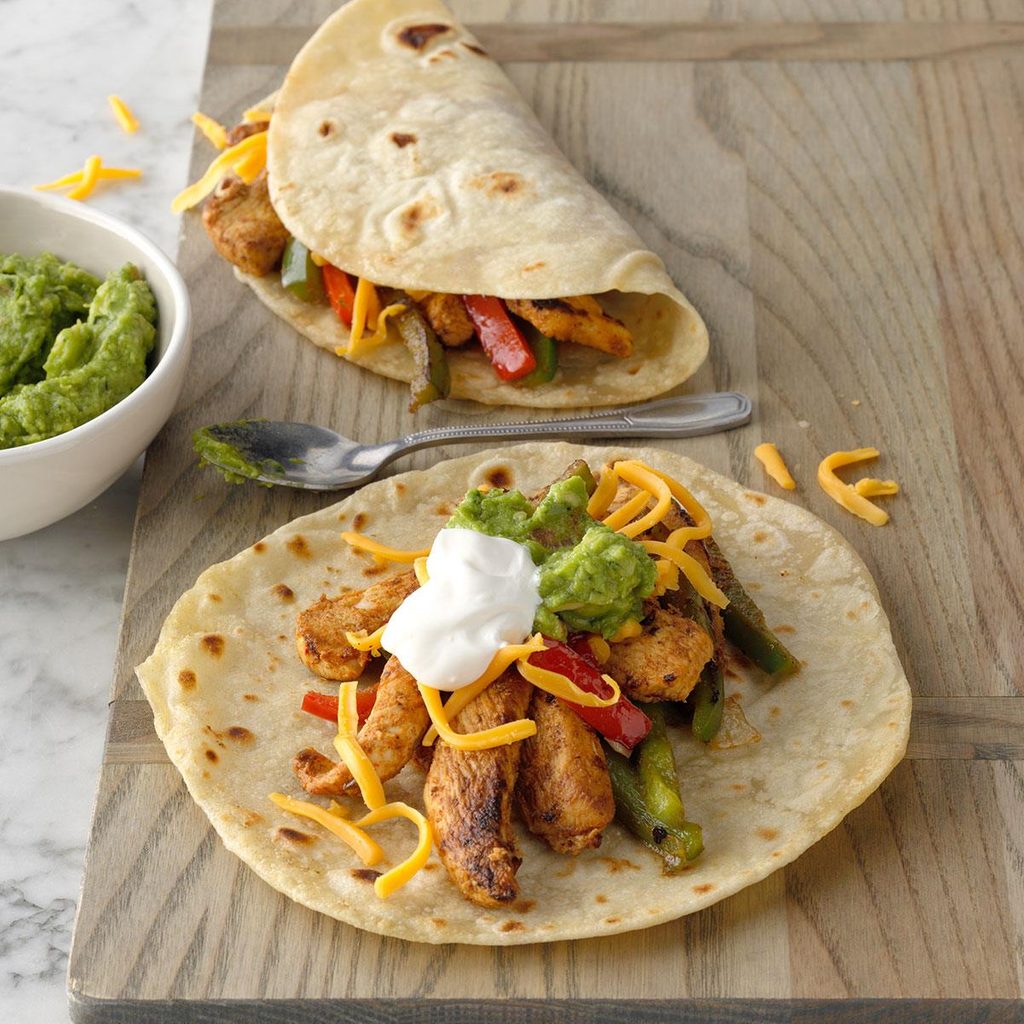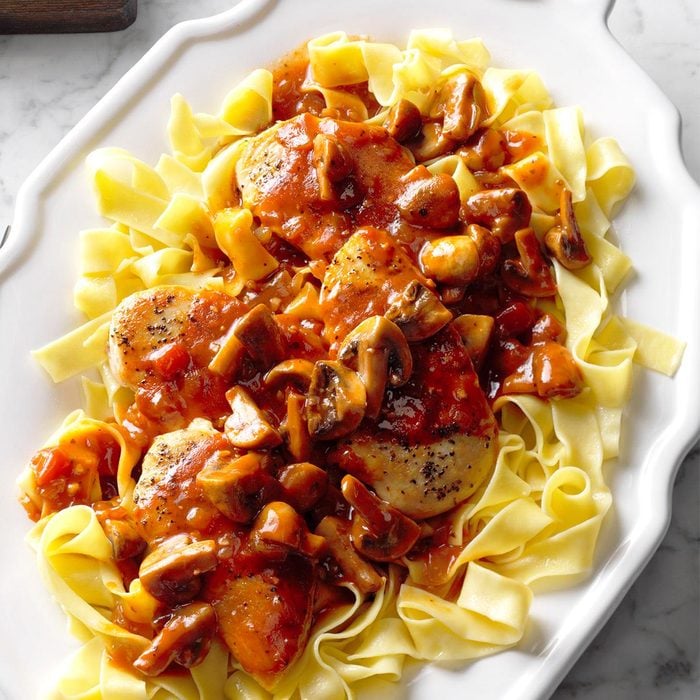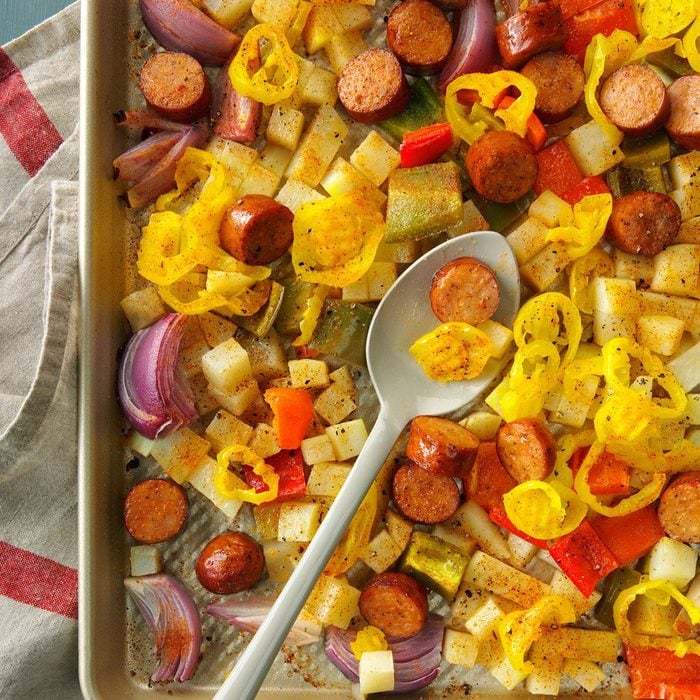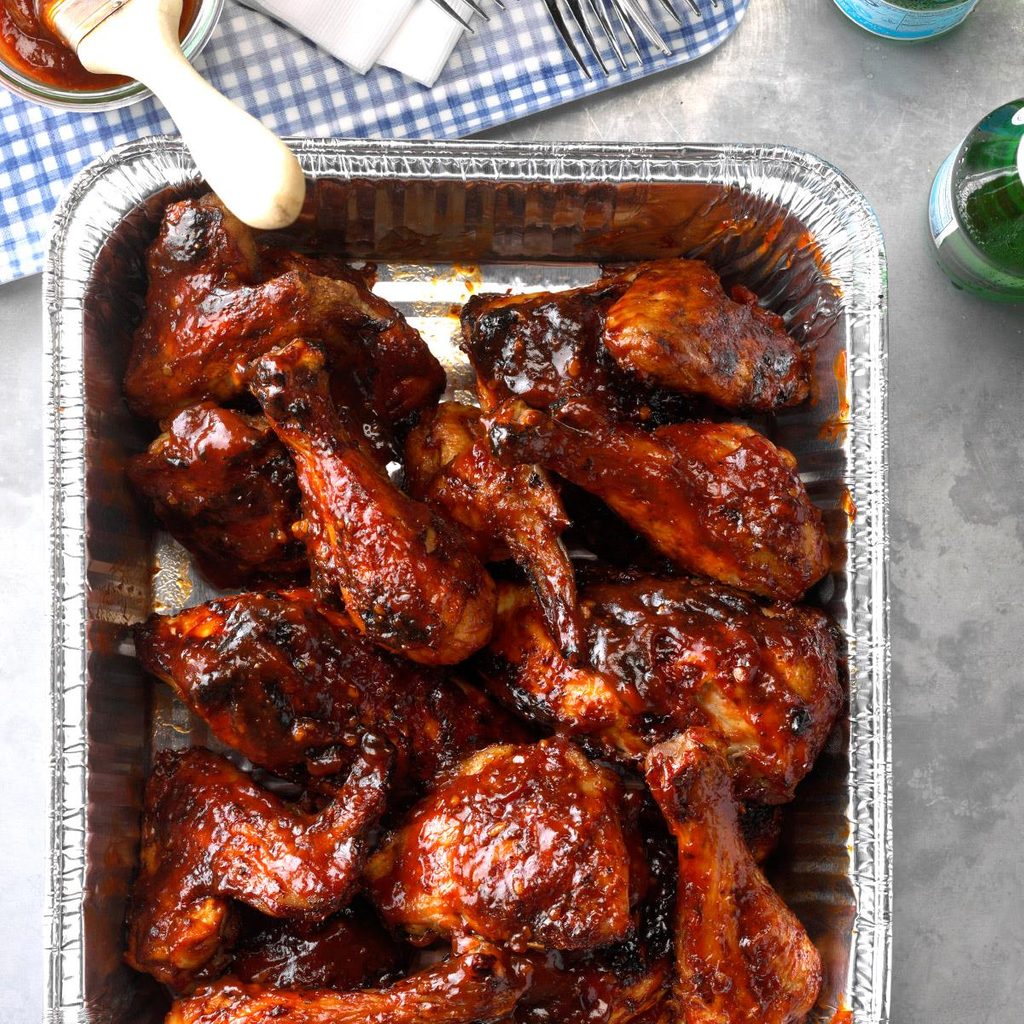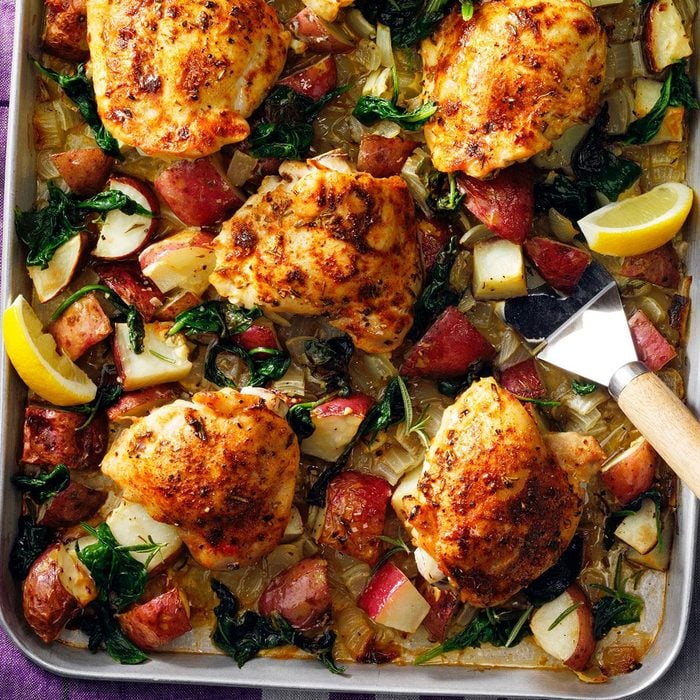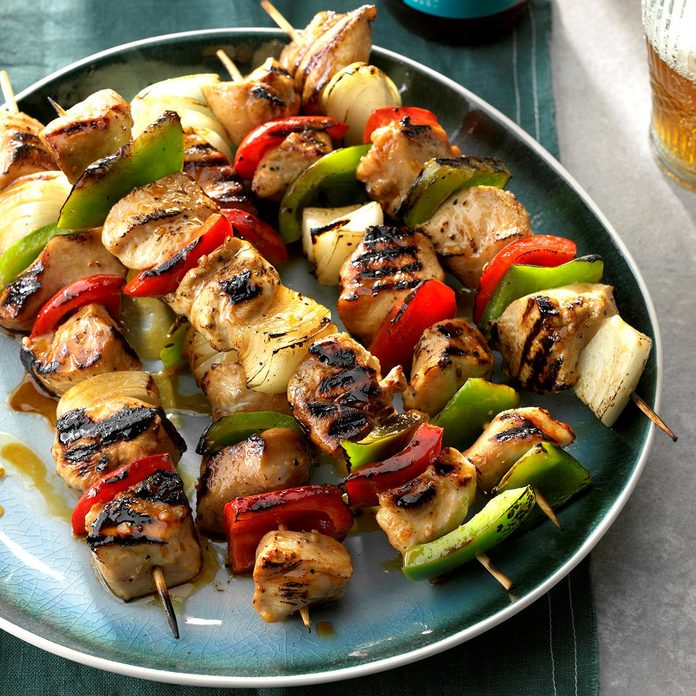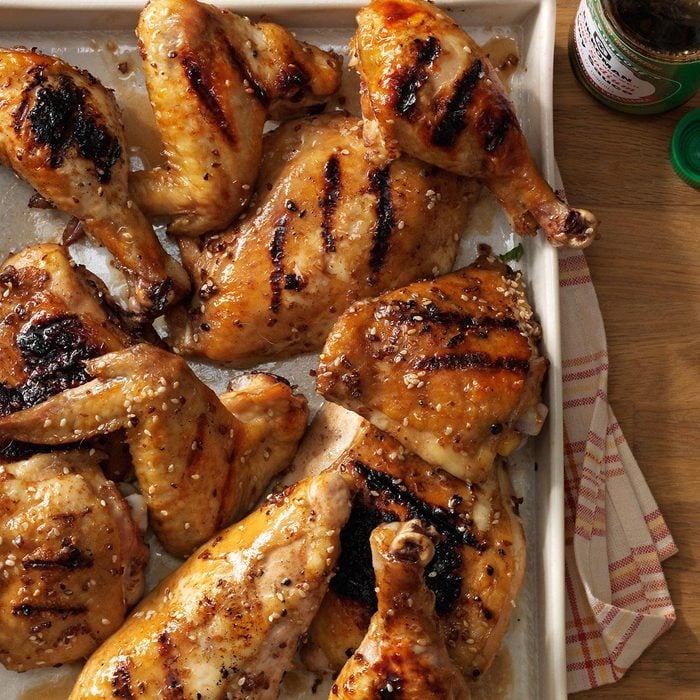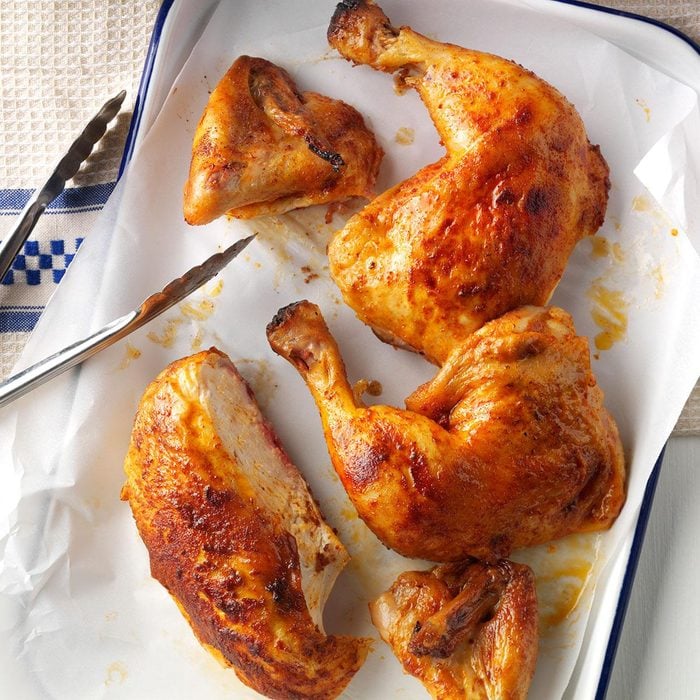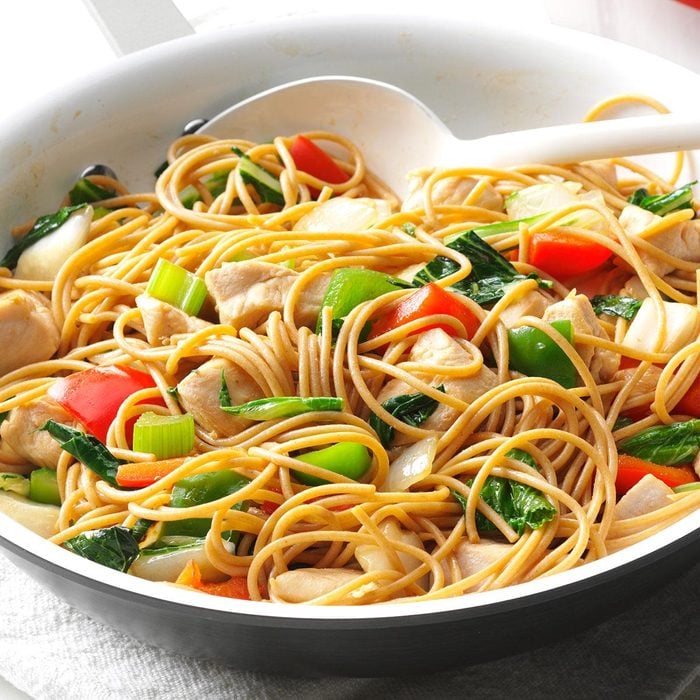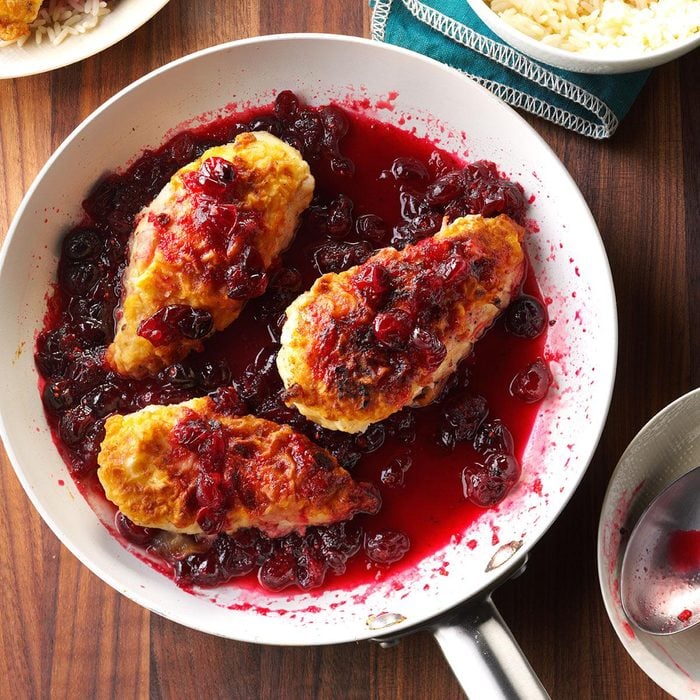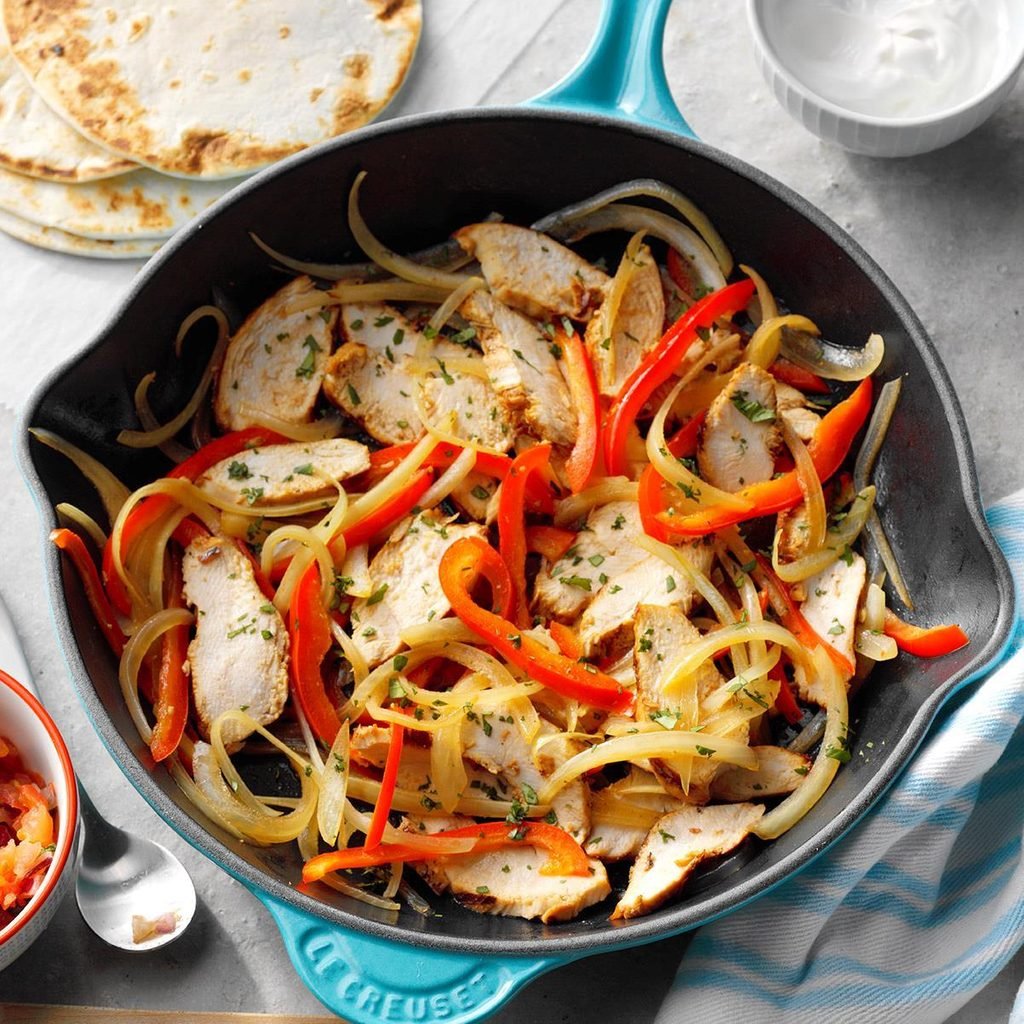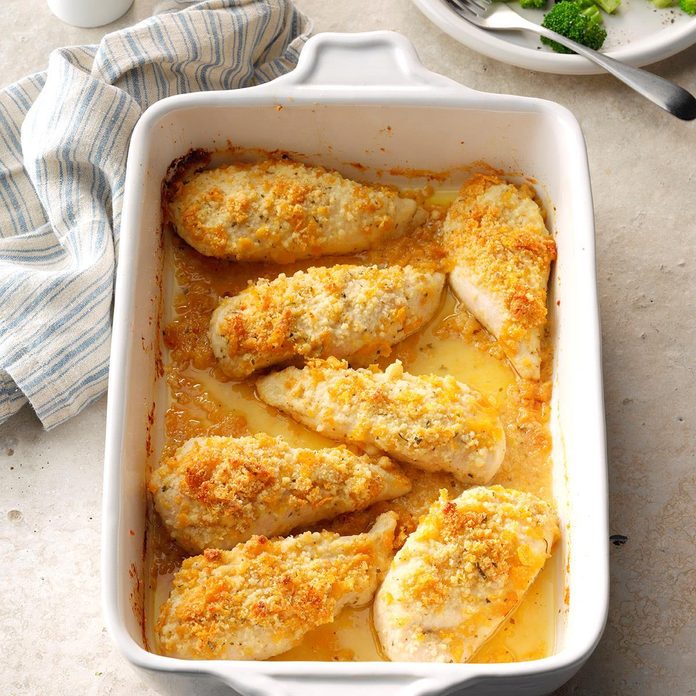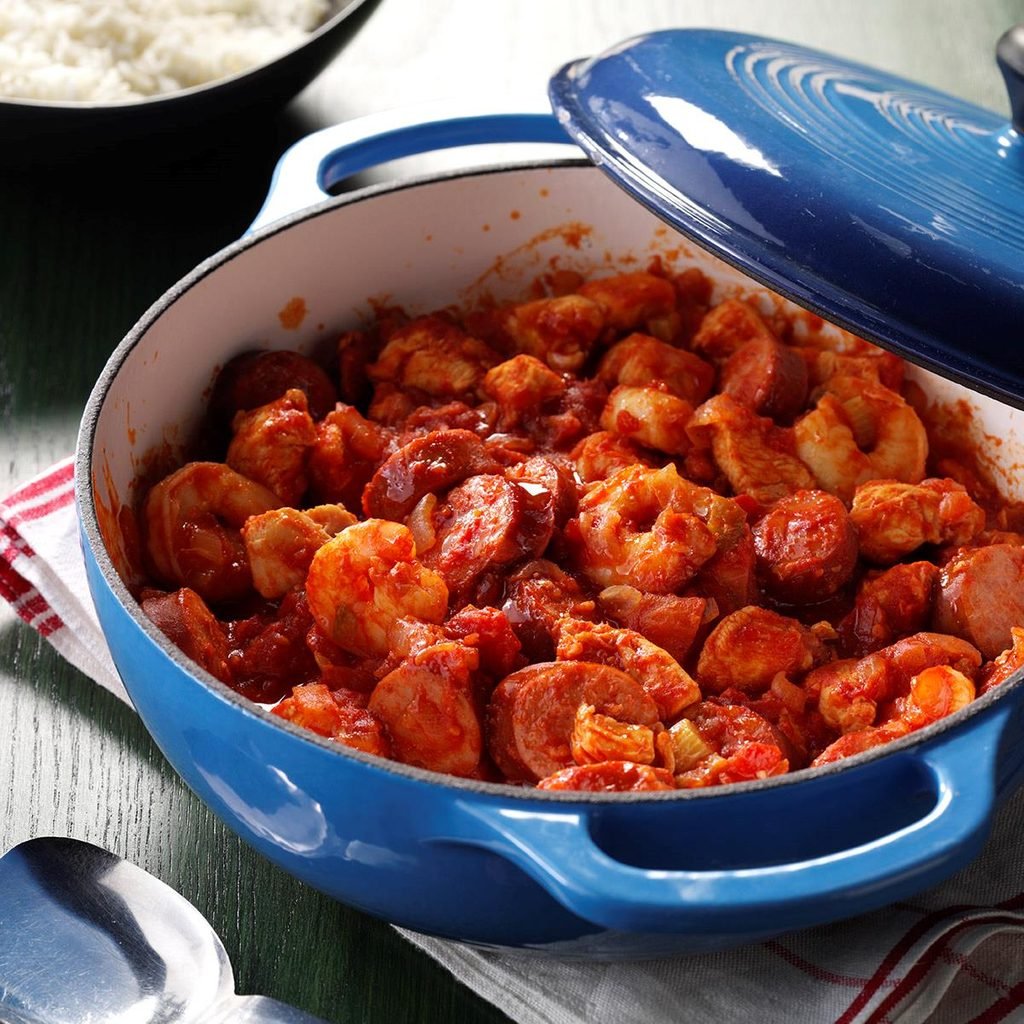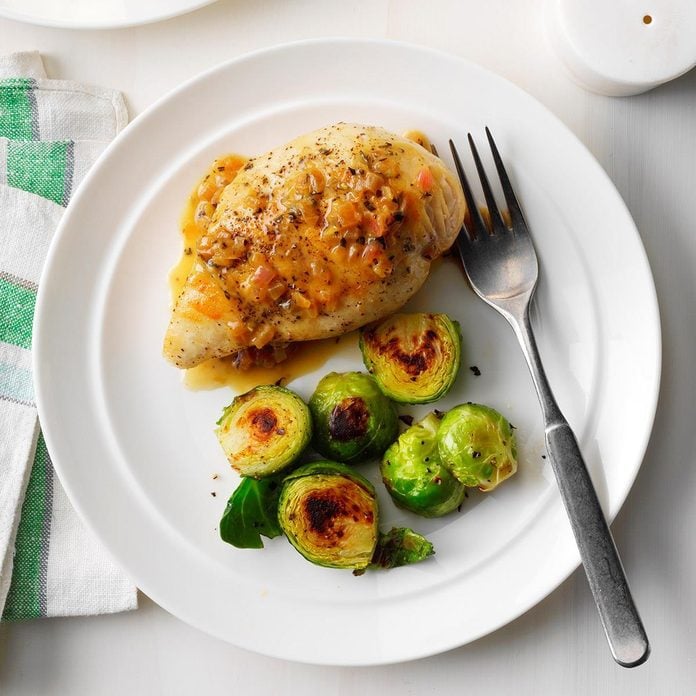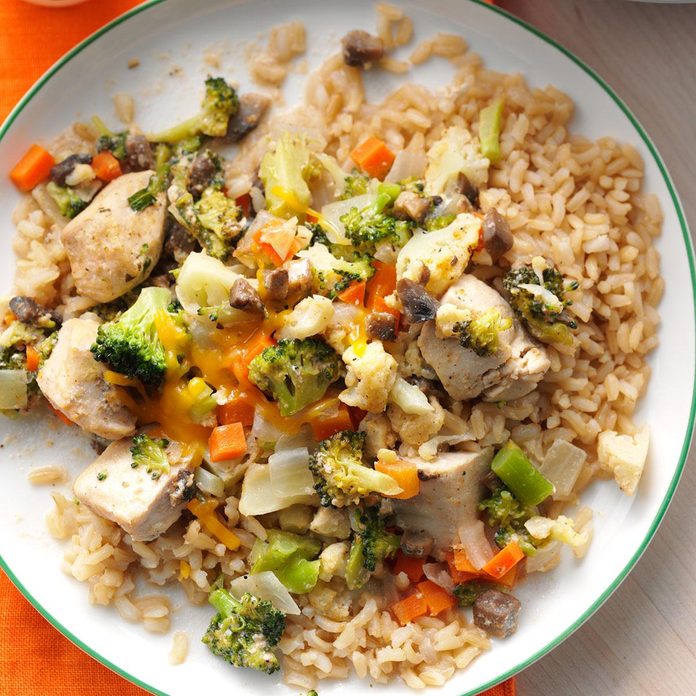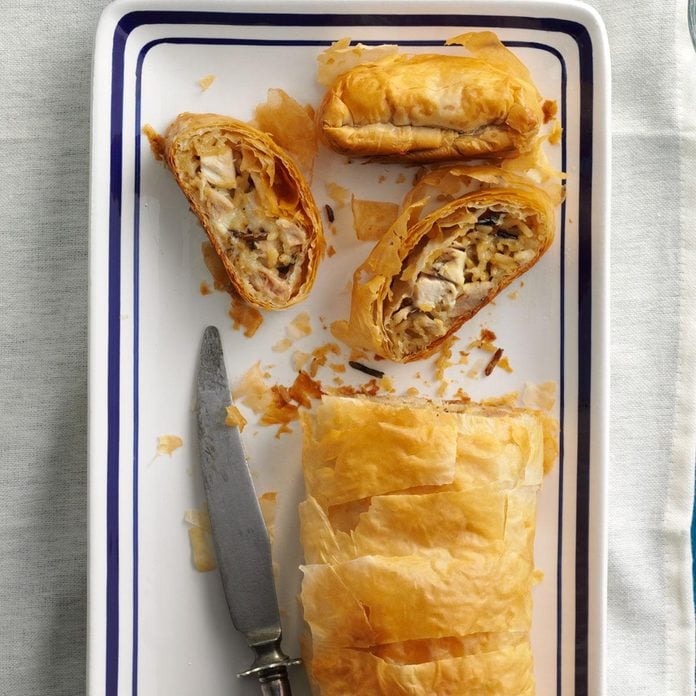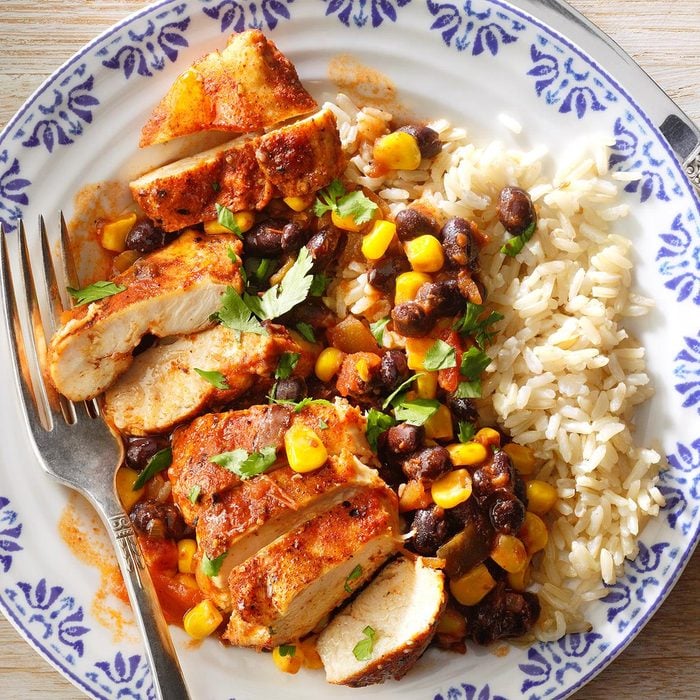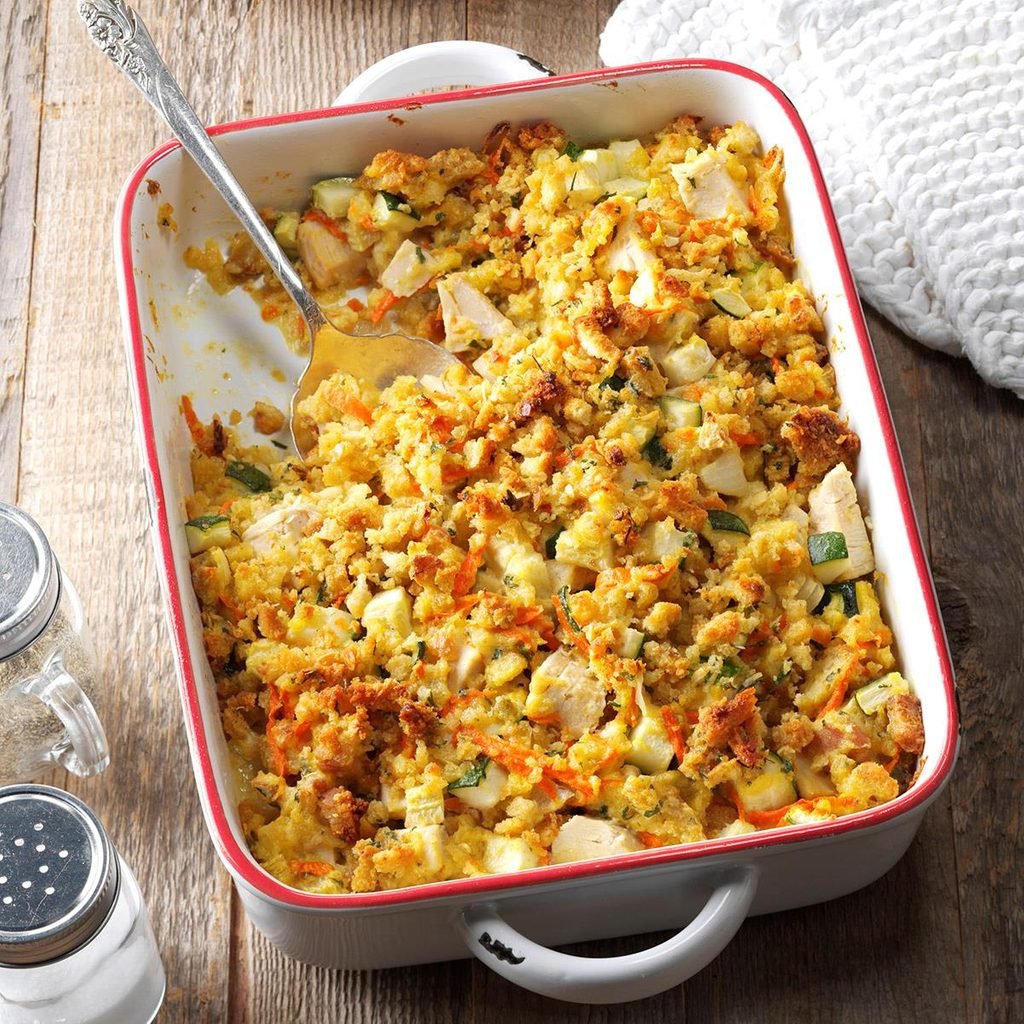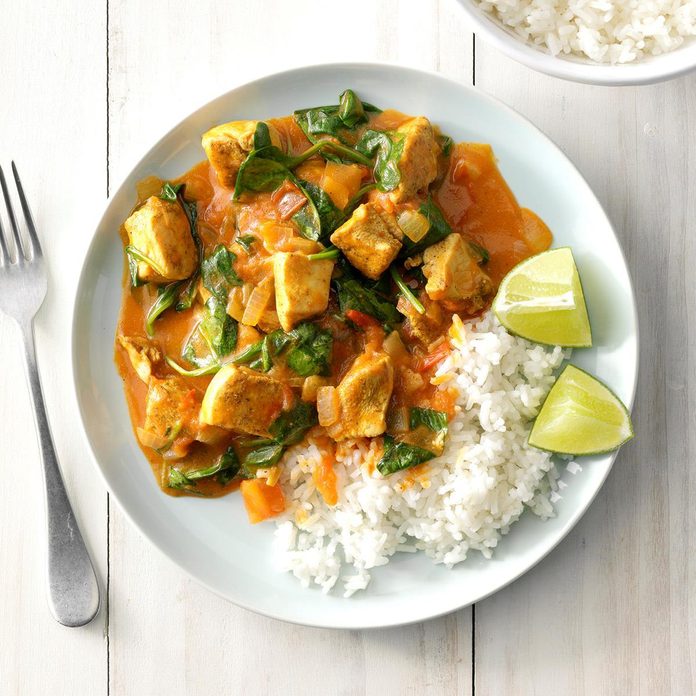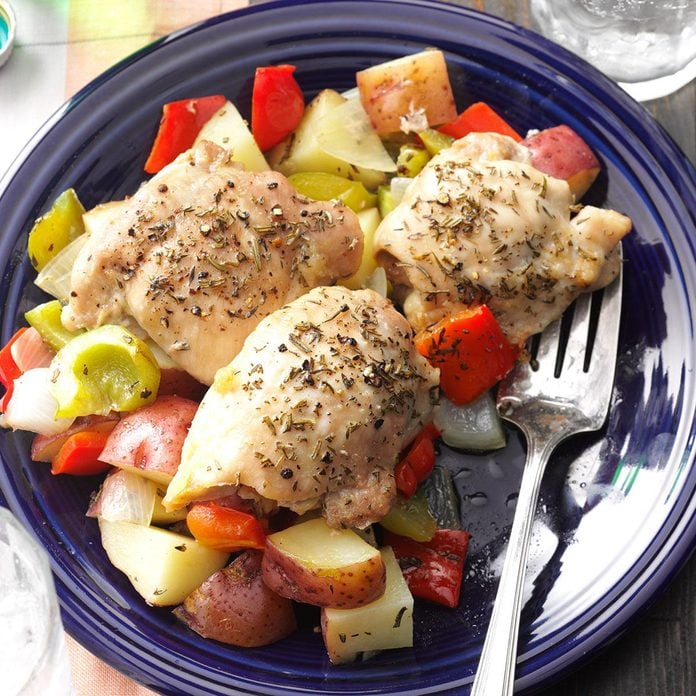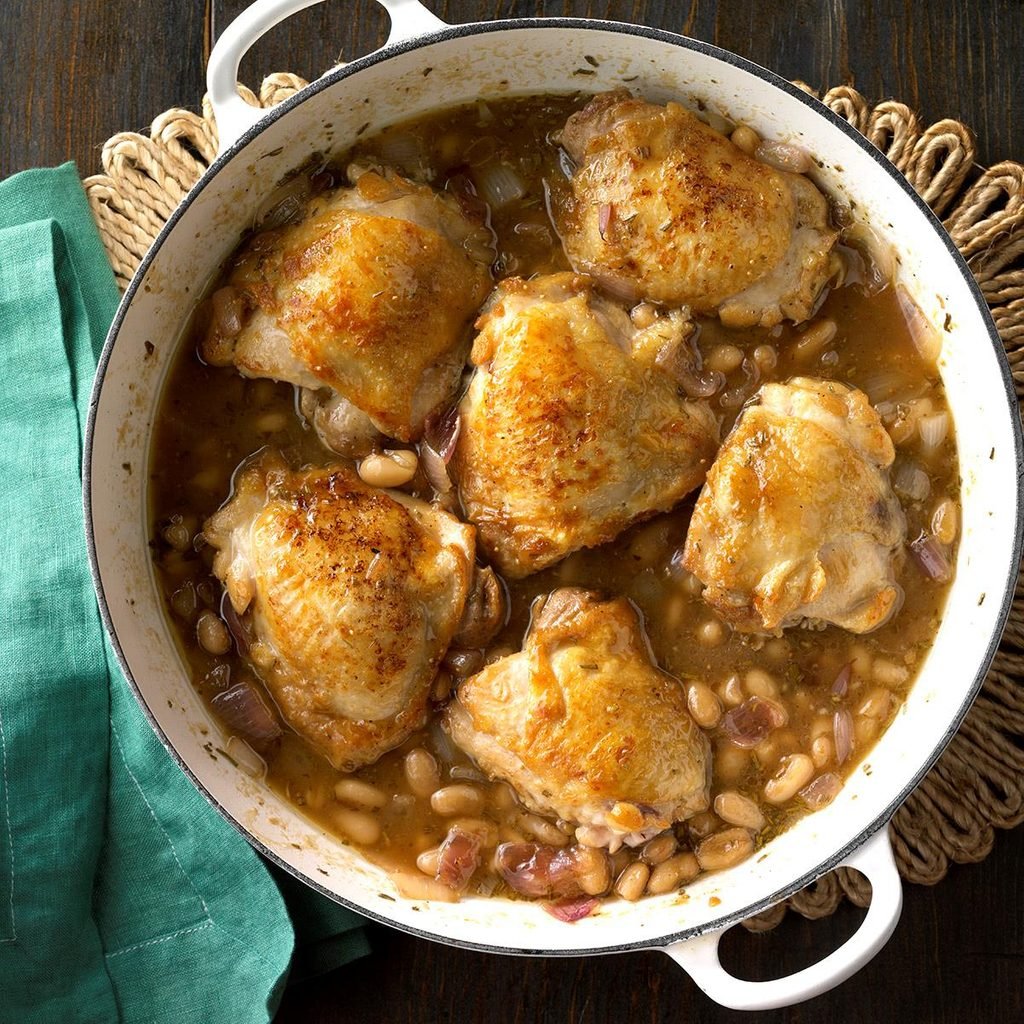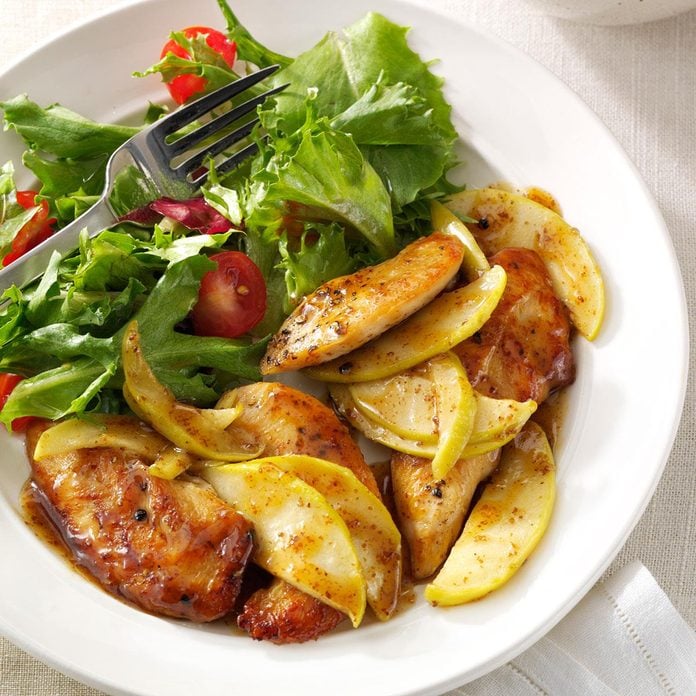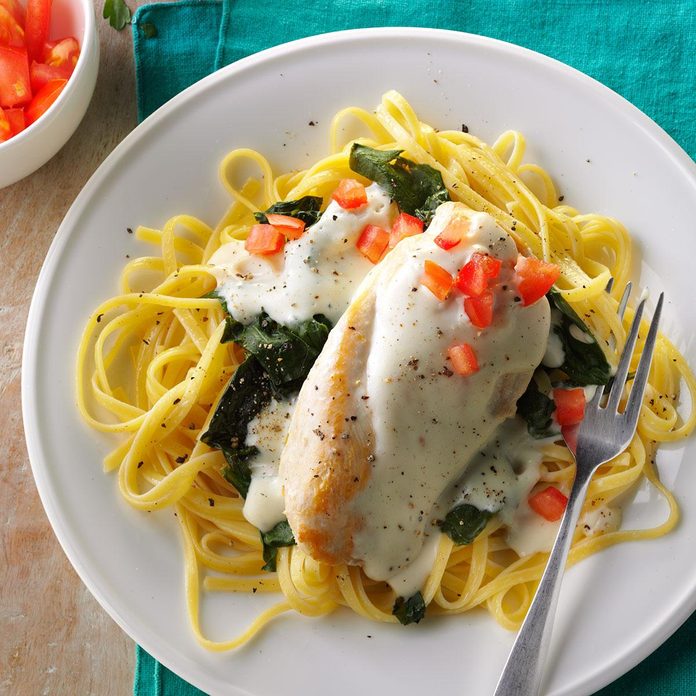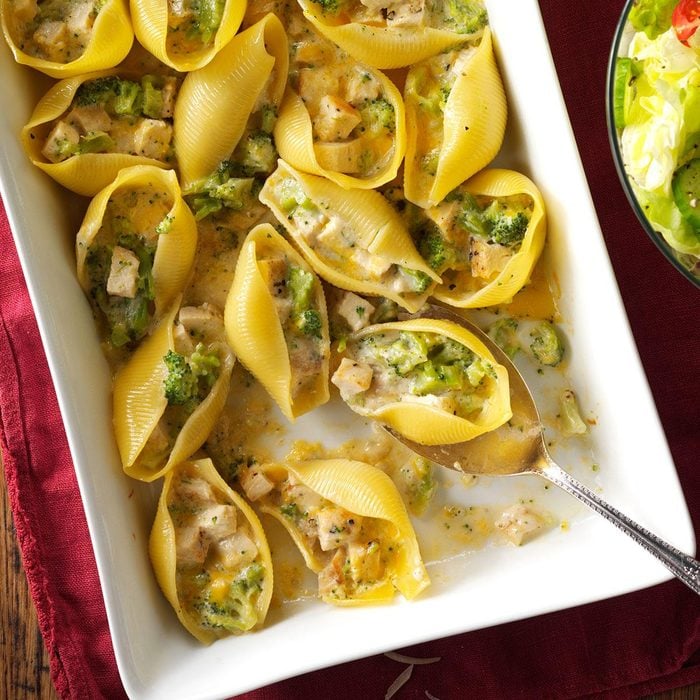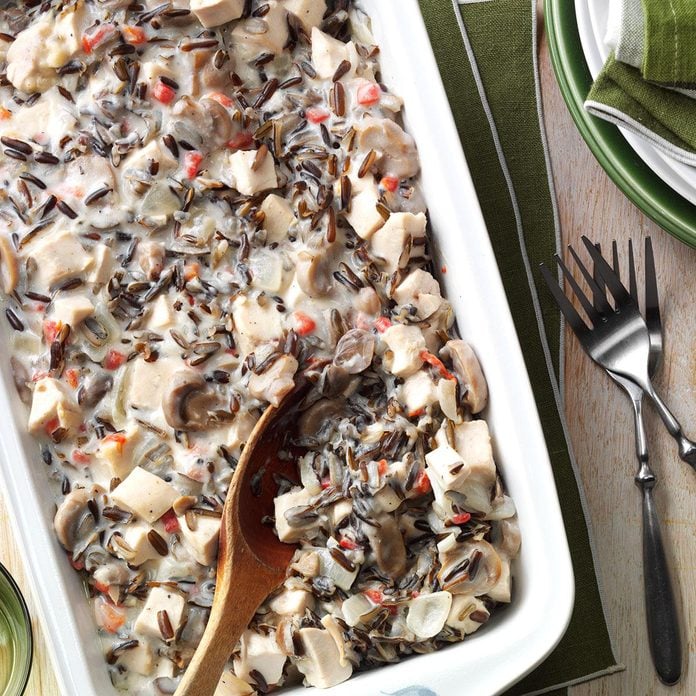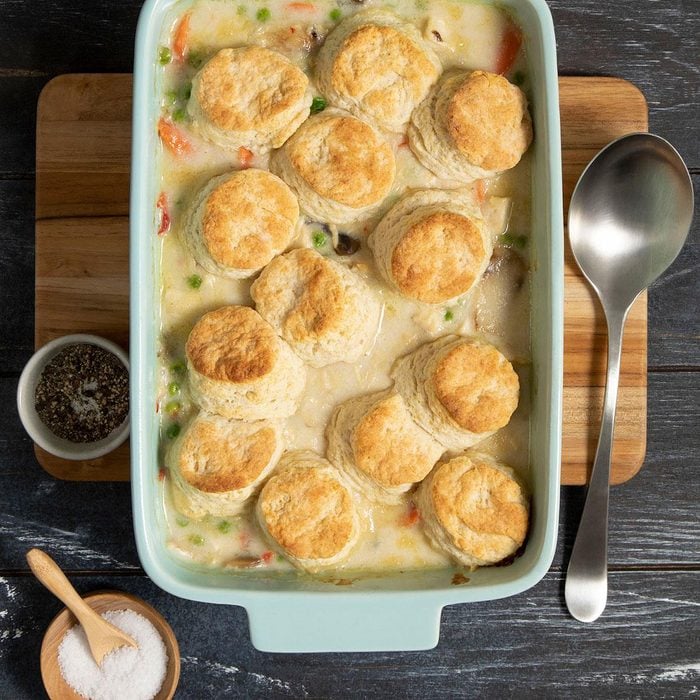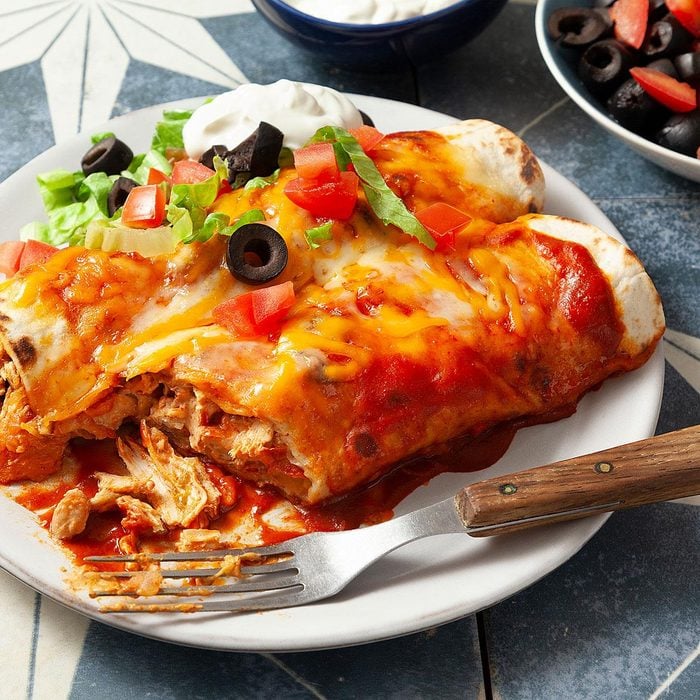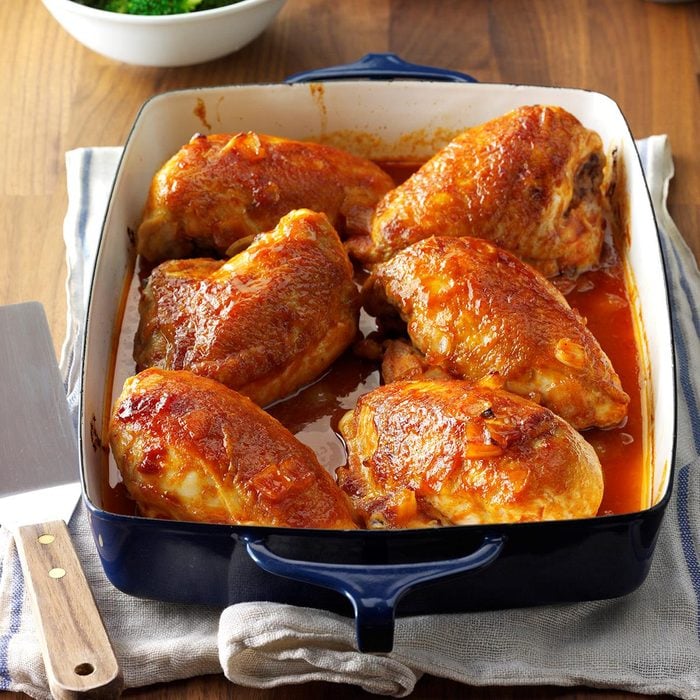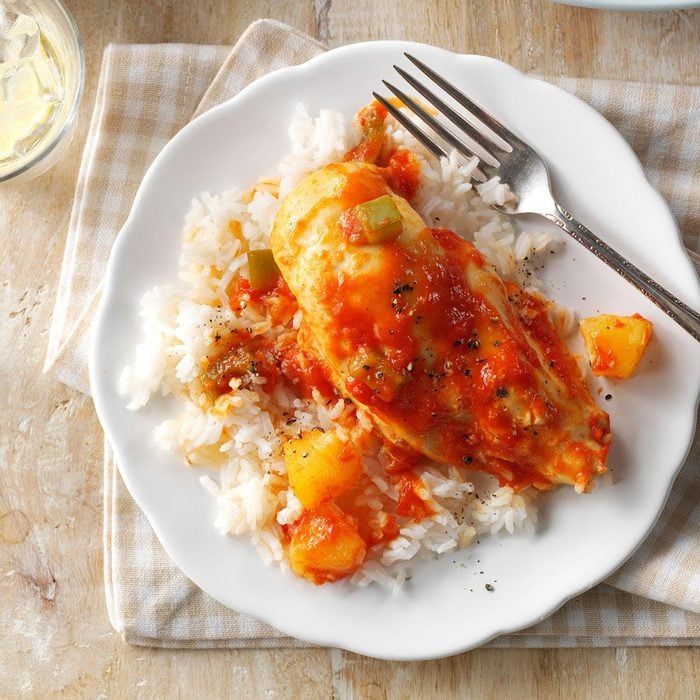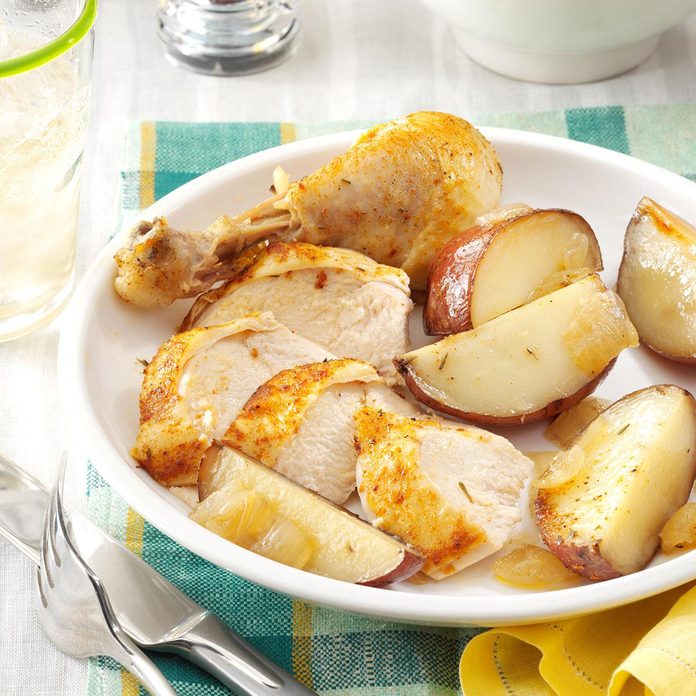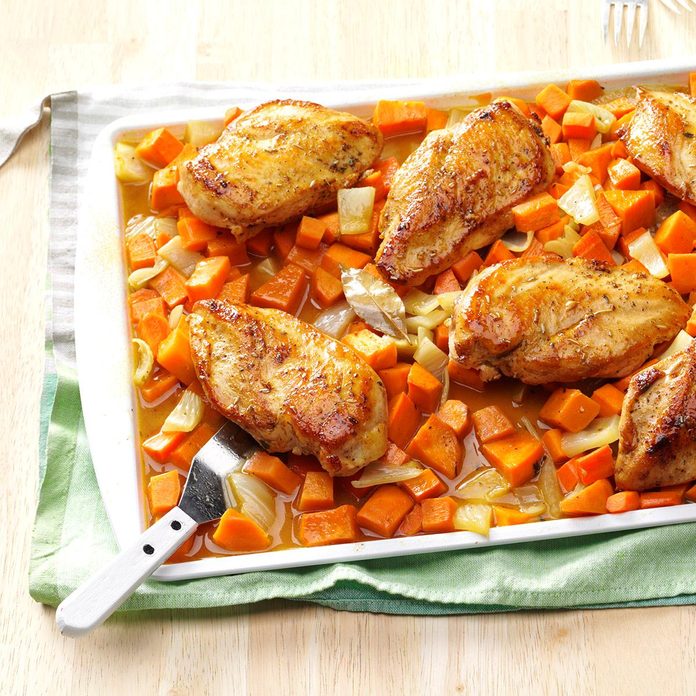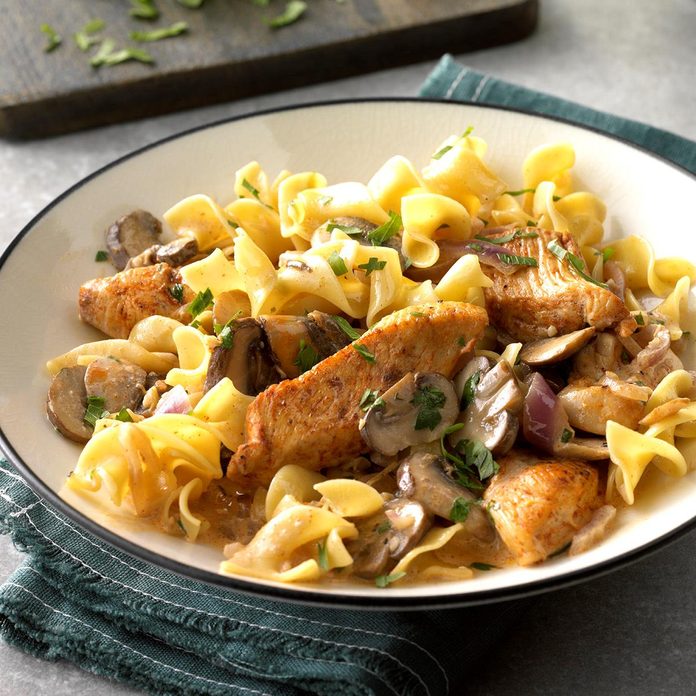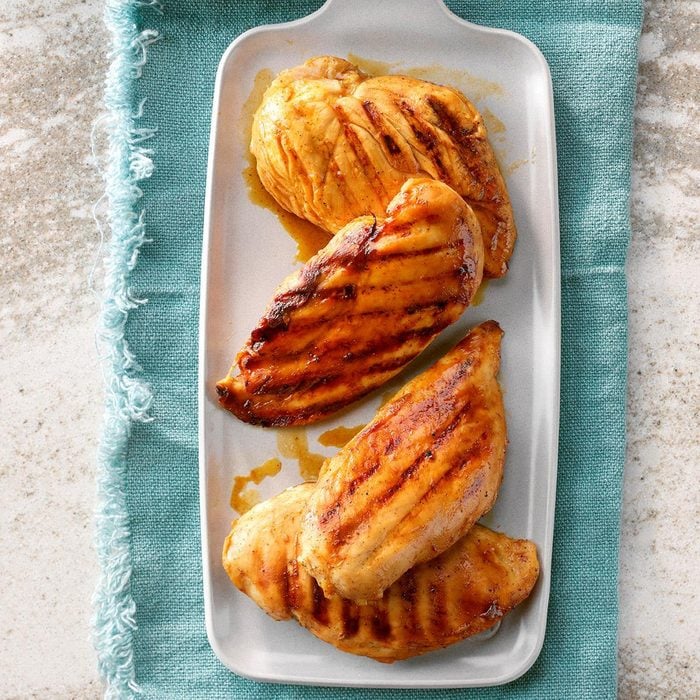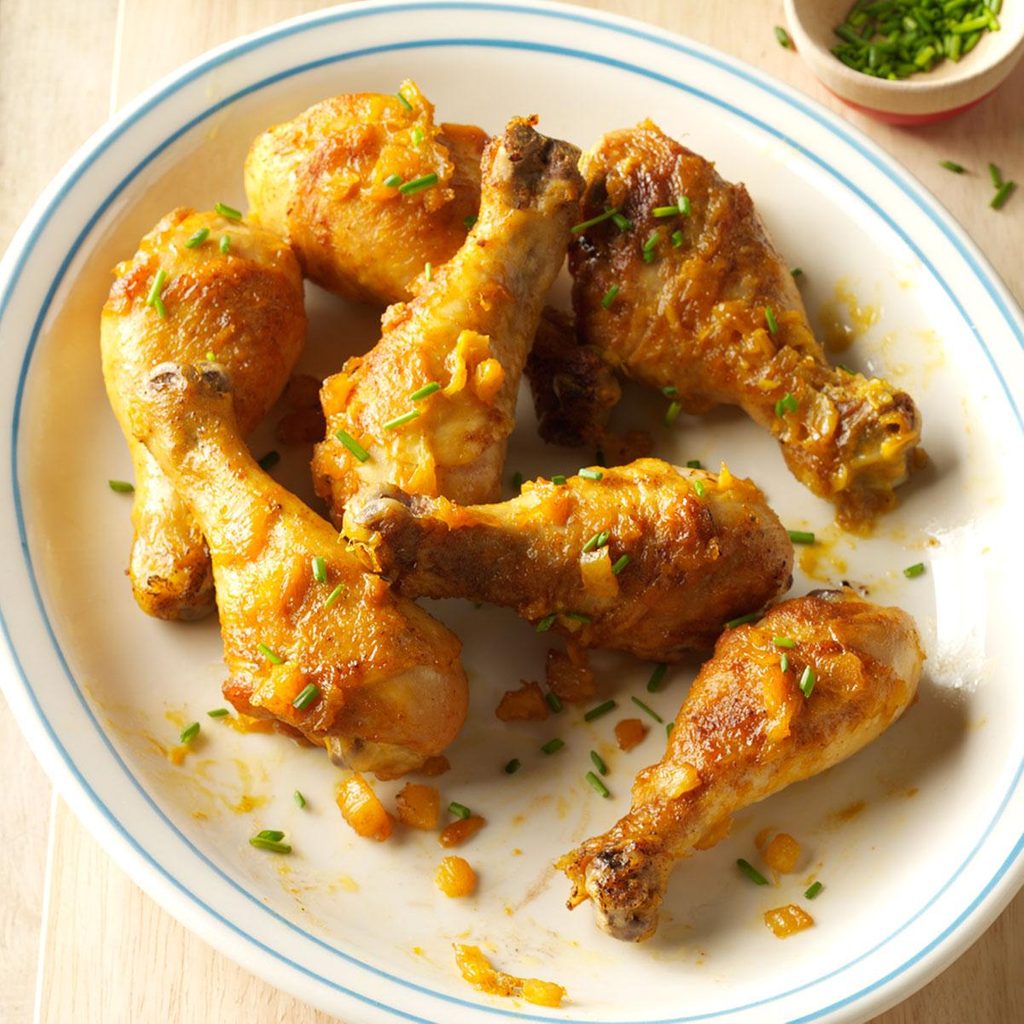Filipino Chicken Adobo
My mom always makes her saucy Chicken Adobo recipe when I come home to visit. I think it's even better the next day as leftovers —she says it's because of the vinegar. — Michael Moya, Taste of Home Senior Marketing Manager
Get Recipe
Mexican Chicken Fajita PizzaThis Mexican chicken pizza has always been a hit with my kids and it’s such a great way to sneak in extra vegetables. —Carrie Shaub, Mount Joy, Pennsylvania
Chicken Cakes with Avocado Mango SauceHere's a fabulous appetizer for your next party. Or serve these chicken cakes for dinner with a side of hot rice and your favorite vegetable. —Rachael Nodes, La Barge, Wyoming
Buffalo Chicken Meat LoafHere's a great way to spice up a plain chicken meat loaf. It combines two of my favorite Sunday afternoon foods into one easy-to-make meal that's a huge hit with my family. —Holly Jones, Kennesaw, Georgia
Barbecued Chicken Salad SandwichesAn impromptu picnic inspired this BBQ chicken salad sandwich. An instant summertime favorite, these dressed-up sandwiches have become a mainstay at our house. —Linda Orme, Battleground, Washington
Spanish-Style PaellaIf you enjoy cooking ethnic foods, this hearty rice dish is wonderful. It's brimming with generous chunks of sausage, shrimp and veggies. —Taste of Home Test Kitchen
Contest-Winning Hot Chicken SaladAfter I tasted this hot chicken salad at a women's luncheon, I left with the recipe in hand. I was our city clerk for several years, and on election days I brought this to serve our poll workers for lunch. It got everyone's vote of approval! I've found it is also delicious stuffed in a tomato. —Ruth Glabe, Oronoco, Minnesota
Chicken Chiles Rellenos AlfredoThis recipe combines my daughter's love of chiles rellenos and my love of chicken Alfredo! To cut down on the spice level you could substitute Monterey Jack cheese for the pepper jack. —Jennifer Stowell, Smithville, Missouri
Buffalo Chicken AlfredoMy family loves this quick Buffalo chicken Alfredo! It became an instant favorite. I like to use Frank's cayenne pepper sauce, but if you like things on the milder side, just use a little less. —Lauren Wyler, Dripping Springs, Texas
Moroccan Chicken ThighsMy husband and I love Mediterranean and Middle Eastern food. This recipe is very flavorful, so it's quickly become one of our favorites. —Susan Mills, Three Rivers, California
Goat Cheese and Spinach Stuffed ChickenThis spinach-stuffed chicken breast recipe is special to me because it has so much flavor, yet not too many calories. I love Italian food, but most of the time it is too heavy. This is a healthy twist on an Italian dish! —Nicole Stevens, Mount Pleasant, South Carolina
Contest-Winning Greek Pasta BakeWhen I take this dish to potlucks, there's never so much as a morsel left! It’s a simple, healthy, hearty supper made with ingredients that are easy to find. Add a salad and a crusty loaf of bread for a quick meal solution. —Anne Taglienti, Kennett Square, Pennsylvania
Chicken and Egg HashThis chicken and eggs recipe is one of my daughter's favorites. To reduce cooking time and clean out the fridge, dice up leftover potatoes and use pre-cooked meat. —Joyce Price, Whitefish, Ontario
Scalloped Chicken CasseroleThis is a great catchall meal-in-one dish. Any meat can be used, and vegetables may be substituted based on what you have available.—Marion White, La Center, Washington
Slow-Cooker Country Captain ChickenLegend has it that the recipe for country captain chicken was brought to Georgia in the early 1800s by a British sea captain. Although it's traditional to serve this over rice, it's also delicious with noodles or mashed potatoes. —Suzanne Banfield, Basking Ridge, New Jersey
Cajun Chicken LasagnaDestined to be a new favorite with all around the table, this zesty take on traditional Italian lasagna is a nod to the Gulf Coast. Increase the amount of Cajun seasoning if you like spicier fare. —Mary Lou Cook, Welches, Oregon
Savory Mustard Chicken and Stuffing WafflesAdding mustard to the chicken coating adds a tang that's amazing with the savory waffles and sweet maple syrup. —John Ginn, Carlisle, Pennsylvania
California Chicken Club PizzaInspired by the California Club pizza from California Pizza Kitchen, I decided to whip up my own version. It's loaded with tons of fresh veggies, so that means it has to be good for you, right? —Robert Pickart, Chicago, Illinois
Creole Skillet DinnerWhile living in Canada, I sampled this colorful dish at a neighbor's. The following Christmas, I served it instead of my traditional turkey, and I received numerous compliments on it. I frequently substitute shrimp or sausage for the chicken ... or add all three. —Bonnie Brann, Pasco, Washington
Chicken Wings FricasseeThese old-fashioned sautéed chicken wings with flavorful gravy are equally impressive and inexpensive. They usually draw compliments—and second helpings.—Sundra Lewis, Bogalusa, Louisiana
Easy Chicken Pesto Stuffed PeppersOn busy weeknights, I don’t want to spend more than 30 minutes preparing dinner, nor do I want to wash a towering pile of dishes. This recipe delivers on both counts without having to sacrifice flavor! —Olivia Cruz, Greenville, South Carolina
Nacho ChickenI have been serving this rich and zippy chicken casserole for years, and it's a favorite of my family and friends. It disappears quickly at bring-a-dish gatherings, too. —Thom Britton, Three Rivers, Michigan
Baked Nectarine Chicken SaladFolks love the crunchy chow mein noodles on top. I love that I can make it a day in advance and refrigerate until it's time to serve. Serve with hot bread or rolls. —Faye Robinson, Pensacola, Florida
Blueberry-Dijon ChickenBlueberries and chicken may seem like a strange combination, but prepare to be pleasantly surprised. I add a sprinkling of minced fresh basil as the finishing touch. —Susan Marshall, Colorado Springs, Colorado
Teriyaki Glazed ChickenI love to experiment with food. We're able to buy sweet onions grown on Maui, so I stir-fry them with chicken and carrots for a tasty teriyaki meal. —Kelly Brenneman, Riverdale, California
Chicken Bulgur SkilletThis recipe was passed on to me by a friend. I've altered it slightly to suit our tastes. We like it with a fresh green salad. —Leann Hilmer, Sylvan Grove, Kansas
Pineapple-Ginger Chicken Stir-FryI found the original recipe for this dish on a can of pineapple slices in the 1980s. After making it for a number of years, I lightened the ingredients and adapted it to a quick skillet meal. My family gave it a big thumbs-up, and we've enjoyed it this way ever since! —Sue Gronholz, Beaver Dam, Wisconsin
Barbecue Chicken QuesadillasWhen my kids were small, I'd stuff leftover chicken into these oven-baked quesadillas. I often grab rotisserie chicken instead. —Pam Martin, Canandaigua, New York
Chicken-Stuffed Cubanelle PeppersHere's a different take on traditional stuffed peppers. I substituted chicken for the beef and used Cubanelle peppers in place of the green peppers that are usually featured in such a dish. —Ron Burlingame, Canton, Ohio
Sassy Chicken & PeppersThis quick and healthy chicken and peppers recipe tastes like a naked taco and is bursting with fresh flavors. And it can all be prepared in the same pan for easy cleanup—it's a win-win! —Doris Heath, Franklin, North Carolina
Gulf Coast Jambalaya RiceAs the stew of the South, jambalaya is a definite staple. For ages, home cooks have been making their own tweaks on the traditional recipe. This rendition is my favorite. —Judy Batson, Tampa, Florida
Garlic Chicken with HerbsPan-roasting garlic cloves turns them into rich, creamy deliciousness. This chicken is also fantastic with a loaf of crusty bread or mashed potatoes on the side. —Kathy Fleming, Lisle, Illinois
Apple Cider Chicken 'n' DumplingsI came up with this recipe one fall when I had an abundance of apple cider. Adding some to a down-home classic was a delectable decision.
—Margaret Sumner-Wichmann, Questa, New Mexico
Chicken Caesar PizzaDressed greens on top of warm pizza may sound a little strange but trust me, it's fantastic. —Tracy Youngman, Post Falls, Idaho
SpiedisThis is our favorite cookout dish, and it's very good served with a salad. This recipe originated here in my hometown in the 1930s. Our meat preference for speidis is venison, but we use chicken and beef when it's not available. —Gertrude Skinner, Binghamton, New York
Chicken-Pepper AlfredoWhen I want a lighter dinner, I use lean turkey bacon in this recipe. It gives the pasta that richness you want without all the extra fat. —Courtney Harris, Denton, Texas
Curry Chicken and RiceI updated this chicken and rice dish by adding veggies and cashews to give it fresh and crunchy appeal. The green chiles in the tomatoes give it just the right little kick, but if you really like spice, add fresh, diced jalapeño. —Denise Klibert, Shreveport, Louisiana
Balsamic Roasted Chicken Thighs with Root VegetablesI will always remember the way my grandmother's house smelled when she made these balsamic chicken thighs every Sunday. Ever since she gave me the recipe, the heartwarming flavors always take me back to my childhood. — Erin Chilcoat, Central Islip, New York
Baked Chicken ChalupasI wanted an easy alternative to deep-fried chalupas, so I bake them with filling on top. —Magdalena Flores, Abilene, Texas
Chili Chicken StripsInstead of ordinary bread crumbs, seasoned crushed corn chips coat these slightly crunchy chicken fingers. If your family likes food with some heat, use the full 1-1/2 teaspoons of chili powder. —Taste of Home Test Kitchen
Cheesy Bow Tie ChickenHere's a super-simple dish that tastes like it's straight from a nice Italian restaurant. Spinach-artichoke dip is usually available in supermarket delis. It comes frozen, too. Just make sure to thaw it according to the package directions before dinnertime. —Sally Sibthorpe, Shelby Township, Michigan
Chiles Rellenos Grilled Chicken TacosA local restaurant makes awesome charred tacos that are a lot like these. Their marinade recipe’s a secret, so I invented my own. Light the coals and have them anytime. —Denise Klibert, Shreveport, Louisiana
Chicken Alfredo with Grilled ApplesIf you've never grilled apples before, here's your excuse to start. I created this Alfredo-style chicken for a party. By the number of recipe requests, I knew it was a hit. —Richard Robinson, Park Forest, Illinois
New England Bean & Bog CassouletWhen I moved to New England, I embraced the local cuisine. My cassoulet with baked beans pays tribute to a French classic and to New England in one hearty, heartwarming dish. —Devon Delaney, Westport, Connecticut
Sweet Tea Barbecued ChickenMarinades sometimes use coffee or espresso, and that inspired me to try tea and apple juice to perk up this sauce. —Kelly Williams, Forked River, New Jersey
Chicken Quinoa Bowls with Balsamic DressingI love this recipe because its simplicity allows me to spend time with my family while not sacrificing taste or nutrition. Plus the fresh spring flavors really shine through! —Allyson Meyler, Greensboro, North Carolina
Grilled Lemon ChickenMy chicken gets its subtle pucker from lemonade concentrate. So simple, so sweet! —Linda Nilsen, Anoka, Minnesota
Chicken Artichoke SkilletMy fast chicken entree featuring artichokes and olives has real Greek flair. Seasoned with lemon juice and oregano, the stovetop chicken turns out moist and tender. —Carol Latimore, Arvada, Colorado
Chicken & Cheddar Biscuit CasseroleI always get rave reviews when I bring this casserole to my son's Cub Scout meetings.This is the perfect comfort meal after a long day. —Sarah Phillips, East Lansing, Michigan
Chicken Butternut ChiliAt our house, we just love a good comforting, hearty, tomato-based chili with bold flavors! This unique chili is loaded with veggies and flavor. You can also prepare the recipe in the slow cooker. Just add ingredients to the crock and cook over high heat for about 4 hours. —Courtney Stultz, Weir, Kansas
Spinach and Feta Stuffed ChickenMy chicken bundles are simple, clean and comforting. Serve them with wild rice and green beans for one of our favorite meals. —Jim Knepper, Mount Holly Springs, Pennsylvania
Tangerine Chicken TagineMy family and friends love foods from around the world, especially Moroccan entrees, so I created this flavorful dish. Cooking it in the slow cooker keeps each morsel moist and rich in flavor. —Brenda Watts, Gaffney, South Carolina
Chicken Parmesan Stuffed ShellsWhen chicken Parmesan meets stuffed shells, it's love at first bite. The texture of the chicken holds up in the deliciously creamy and cheesy mixture. —Cynthia Gerken, Naples, Florida
Tex-Mex Chicken StripsI was looking for a way to amp up the flavor of regular chicken strips so I crushed up some leftover corn chips to create a crispy, flavorful coating. —Cynthia Gerken, Naples, Florida
Swiss Mushroom ChickenEveryone enjoys these golden chicken breasts topped with ham, melted Swiss cheese and fresh mushrooms. The entree is easy to prepare but looks and tastes special enough for company. —Jan Baxter, Humarock, Massachusetts
Soupy Chicken Noodle SupperAt least once a week my six-year-old son, also known as Doctor John, hands me a “prescription” for chicken noodle soup. Needless to say, I'm always happy to fill it. —Heidi Hall, North St. Paul, Minnesota
2-for-1 Chicken TetrazziniA good friend shared a version of this recipe with me 35 years ago. I pay it forward by bringing the second casserole to friends when they are unable to cook. —Helen McPhee, Savoy, Illinois
Flavorful Chicken FajitasThis chicken fajitas recipe is definitely on my weeknight dinner rotation. The marinated chicken in these popular wraps is mouthwatering. The fajitas go together in a snap and always get raves! —Julie Sterchi, Campbellsville, Kentucky
Chicken NeapolitanI often prepare a weeks worth of recipes on the weekend and freeze them so I can quickly have dinner ready for our hungry teenage boys after one of their many sports activities. Served over noodles, this moist chicken with a flavorful sauce is a favorite.—Joan Williams, Baltimore, Maryland
Spicy Roasted Sausage, Potatoes and PeppersI love to share my cooking, and this hearty sheet-pan dinner has built a reputation for being tasty. People have actually approached me in public to ask for the recipe. —Laurie Sledge, Brandon, Mississippi
Sheet-Pan Chicken ParmesanSaucy chicken, melty mozzarella and crisp-tender broccoli—all in one pan. What could be better? —Becky Hardin, St. Peters, Missouri
Barbecued Picnic ChickenI like to serve this savory chicken at family picnics. Cooked on a covered grill, the poultry stays so tender and juicy. Everyone loves the zesty, slightly sweet homemade barbecue sauce—and it's so easy to make. —Priscilla Weaver, Hagerstown, Maryland
Sheet-Pan Chicken and VegetablesThis sheet-pan chicken and veggies meal tastes as if it took hours of hands-on time to put together, but the simple ingredients can be prepped in mere minutes. The rosemary gives it a rich flavor, and the meat juices cook the veggies to perfection. It’s unbelievably easy! —Sherri Melotik, Oak Creek, Wisconsin
Honey-Glazed Chicken KabobsThis is my husband’s favorite "special day" meal. I serve it with rice pilaf, salad and grilled garlic bread. —Tracey Miller, Aiken, South Carolina
Tropical Island ChickenThe marinade makes a savory statement in this all-time-favorite chicken recipe that I served at our son's pirate-themed birthday party. It smelled so good on the grill that guests could hardly wait to try a piece! —Sharon Hanson, Franklin, Tennessee
Can-Can ChickenHere's a tasty take on the popular beer-can chicken. Once the bird is on the grill, the work's basically done. And cleanup is a cinch—a must for a guy like me. —Steve Bath, Lincoln, Nebraska
Bacon-Chicken Club PizzaA chicken club pizza topped with lettuce, tomatoes and dressing? You’re in for a treat! Vegetables give the cheesy crust a cool crunch. —Debbie Reid, Clearwater, Florida
Chicken Stir-Fry with NoodlesStir-fry noodles on a cooking show caught my eye. I ran with the idea and loaded mine with veggies. Now it’s our favorite hurry-up meal. —Beverly Norris, Evanston, Wyoming
Tart Cranberry ChickenMy husband loves chicken when it’s nice and moist, as in this autumn recipe. I serve it over hot rice with a salad and warm rolls. The ruby red sauce has a wonderful sweet-tart flavor. —Dorothy Bateman, Carver, Massachusetts
Chicken Fajitas for TwoThis is the best fajita recipe I've ever tried. It sounds complicated, but it really isn't. The servings are hearty, but this dish is so good that my husband and I never have a problem finishing it! —Kathleen Smith, Pittsburgh, Pennsylvania
Breaded Ranch ChickenA crunchy coating of cornflakes and Parmesan cheese add delectable flavor to this zesty ranch chicken. The golden,
cheesy ranch chicken is a mainstay dish I can always count on. —Launa Shoemaker, Landrum, South Carolina
Hearty JambalayaMel Miller of Perkins, Oklahoma shares this meaty and satisfying jambalaya.
Lemon and Rosemary ChickenThis baked rosemary chicken with a tangy lemon sauce is my husband's favorite, and my sister always wants it for her birthday dinner. —Laurel Dalzell, Manteca, California
Spicy Chicken Lettuce WrapsThis is one of my go-to meals when I want a fun dinner. I love the spicy Asian flavors against the cool lettuce and the added crunch of peanuts and water chestnuts. —Brittany Allyn, Nashville, Tennessee
Broccoli-Cauliflower Chicken CasseroleA chicken, broccoli and rice casserole is one of our favorite comfort foods. I make my easy variation in the slow cooker. You can easily substitute whatever cheese you prefer. I sometimes use dairy-free cheese to create a more paleo-friendly dinner. The dish is also delicious sprinkled with a simple bread crumb topping. —Courtney Stultz, Weir, Kansas
Bavarian Apple-Sausage HashThis awesome recipe reflects my German roots. In the cooler months, nothing is as comforting as a hearty hash. Serve this versatile recipe as a side dish at a holiday meal or as a brunch entree over cheddar grits or topped with a fried egg. —Crystal Schlueter, Northglenn, CO
Chicken & Wild Rice StrudelsI wanted the buttery crunch of layered pastry without the sweet filling of strudel. Using rotisserie chicken from the store, I found my savory answer. —Johnna Johnson, Scottsdale, Arizona
Black Bean Chicken with RiceThis spicy family favorite calls for just a few basic ingredients, including chicken, black beans and rice, so it’s quick and easy to stir up in your skillet on a weeknight. —Molly Newman, Portland, Oregon
Chicken Zucchini CasseroleA co-worker shared this chicken zucchini casserole recipe that was originally her grandmother's. When I make it, I use precooked chicken from the grocery store and fresh zucchini my neighbor gives me from his garden. —Bev Dutro, Dayton, Ohio
Creamy Curried ChickenThis is a big hit in our house. My young son and daughter gobble it up. With its irresistible blend of curry and sweet coconut milk, it’ll become a favorite with your family, too. —Tracy Simiele, Chardon, Oh
Roasted Chicken Thighs with Peppers & PotatoesMy family loves this dish! There's nothing better than oven baked boneless chicken thighs for dinner. It looks and tastes like you fussed, but it is really simple to make. These roasted chicken thighs use healthy olive oil and fresh herbs from my garden. —Pattie Prescott, Manchester, New Hampshire
Fig-Glazed Chicken with White BeansSauteed shallots, fig jam, rosemary, lemon and sherry vinegar make a delightful sauce for both the chicken and the beans. My husband couldn’t believe how well the white beans absorbed the flavor, making this a grand slam. Matchstick carrots can be added to the bean mixture for extra color, flavor and crunch. —Arlene Erlbach, Morton Grove, Illinois
Apple-Mustard Chicken TendersMy husband says this dish is sweet and a little bit sassy, just like me. I like to use Granny Smith apples for a bit of tartness. Winesaps are great for this dish, too. —Linda Cifuentes, Mahomet, Illinois
Saucy Garlic ChickenRoasted garlic lends a rich flavor to this appetizing chicken entree, and it complements the spinach nicely. Ideal for entertaining, the recipe can be assembled in advance and popped in the oven when guests arrive. —Joanna Johnson, Flower Mound, Texas
Chicken Broccoli ShellsThis cheesy entree is a make-ahead dream. Just assemble it ahead of time and put it in the oven when company arrives. I round out the meal with a tossed salad and warm bread. —Karen Jagger, Columbia City, Indiana
Contest-Winning Chicken Wild Rice CasseroleWhile this special chicken and wild rice casserole is perfect for a company dinner, it's so good that I often make it for everyday family meals. We think it is very nice served with some crusty rolls or French bread. —Elizabeth Tokariuk, Lethbridge, Alberta
Tex-Mex Chicken with Black Beans & RiceI came up with this
Tex-Mex recipe for my sister who just got her first slow cooker. It’s a delicious go-to recipe for busy days. —Elizabeth Dumont, Boulder, Colorado
Chicken Potpie CasseroleI always have leftover chicken broth on hand and use it for many things, including this comforting family favorite. You can bake your own biscuits as I do or buy them at the store. I like to bake extra biscuits to eat with butter and jam. —Liliane Jahnke, Cypress, Texas
Easy Chicken EnchiladasThis chicken enchiladas recipe is so quick and easy, and I always receive a ton of compliments. It quickly becomes a favorite of friends whenever I share the recipe. Modify the spiciness with the intensity of the salsa and the green chiles to suit your taste. —Kristi Black, Harrison Township, Michigan
Delicious Oven Barbecued ChickenA friend made this saucy chicken for us when we had our first child. I pared down the recipe to make it lower in fat and calories. Now it's a family favorite, and even the kids ask for this baked bbq chicken breast. —Marge Wagner, Roselle, Illinois
Chicken AlohaThis chicken is a welcome way to cook a quick, delicious meal. —Beth Corbin, Sarasota, Florida
Peppery Chicken with PotatoesWe like this recipe because while we go to church on Sundays the chicken cooks and is ready for us when we get home.—Lori Draves, Highland, Wisconsin
Honey-Roasted Chicken & Root VegetablesWhen my whole family comes over for dinner, I make a big platter of roast chicken with sweet potatoes, carrots and fennel. My dad leads the fan club. —Kelly Ferguson, Conshohocken, Pennsylvania
Paprika Chicken StroganoffStroganoff is such a comfort food. While traditionally a beef dish, it can easily be adapted for other proteins, and it is just as delicious. With this creamy chicken stroganoff, I get to enjoy all the lovely sauciness with the benefits of the lighter white meat. —Leo Lo, Norfolk, Virginia
Orange-Spiced ChickenFive ingredients are all you’ll need for this fast and extremely flavorful marinade. With one taste, it’ll become your most-requested chicken recipe! —Debra Stevens, Lutz, Florida
Teriyaki Pineapple DrumsticksWe have a large family and throw big parties, so I look for ways to free my husband from the grill. Roasted drumsticks keep everyone happy. —Erica Allen, Tuckerton, New Jersey
